You might wonder what travelling to Lebanon in 2023 looks like. Is it safe? Is there electricity? What places to visit? Our travel guide gives you answers and valuable tips on how to visit Lebanon on your own.
In Lebanon, you cry twice. Once when you arrive. And once when you are leaving. This is exactly what happened to us, and it is still hard to explain what kind of country Lebanon is. However, we met only the kindest people, tried the most delicious food, saw beautiful nature and on top of that, local transportation is very cheap and frequent. Overall we felt very safe and welcomed.
We put really hard work into this article because we feel Lebanon is a very underrated country. Especially now due to the country’s current economic crisis and instability. Most articles online these days are just updated from travelling a few years ago.
We provide updated information from our visit in April 2022. We tell you how to travel between places, where to stay as some of the hotels you might hear of maybe don’t exist anymore and give you all the information you will need to plan your trip.
QUICK OVERVIEW
Beirut – capital, a fantastic mixture of luxury with war destroyed buildings that are still left as it was. A perfect base for day trips to Saida, Sour (Tyre), Byblos, Batroun, and Zahlé and also manageable but more time-consuming trips to Baalbek, Tripoli and Bcharré (but those three we recommend going overnight).
South Lebanon – visit Saida, a traditional city with an amazing souk. Make sure you try the delicious sweets. Another city, Sour (Tyre), is perfect for seeing a mixture of Christian and Muslim cultures.
North Lebanon – Tripoli is the most traditional town, and it feels like a step back in time. Make a trip to Bcharré, a Christian mountain village that is a perfect base for hiking in Qadisha Valley.
Beeka Valley – close to the borders with Syria lies Baalbek. Home to ancient Roman Ruins that are the most preserved in the Middle East. You can stay in the oldest hotel in Lebanon, built in 1874. On the way between Beirut and Baalbek, there is Zahle, perfect for some wine tasting.
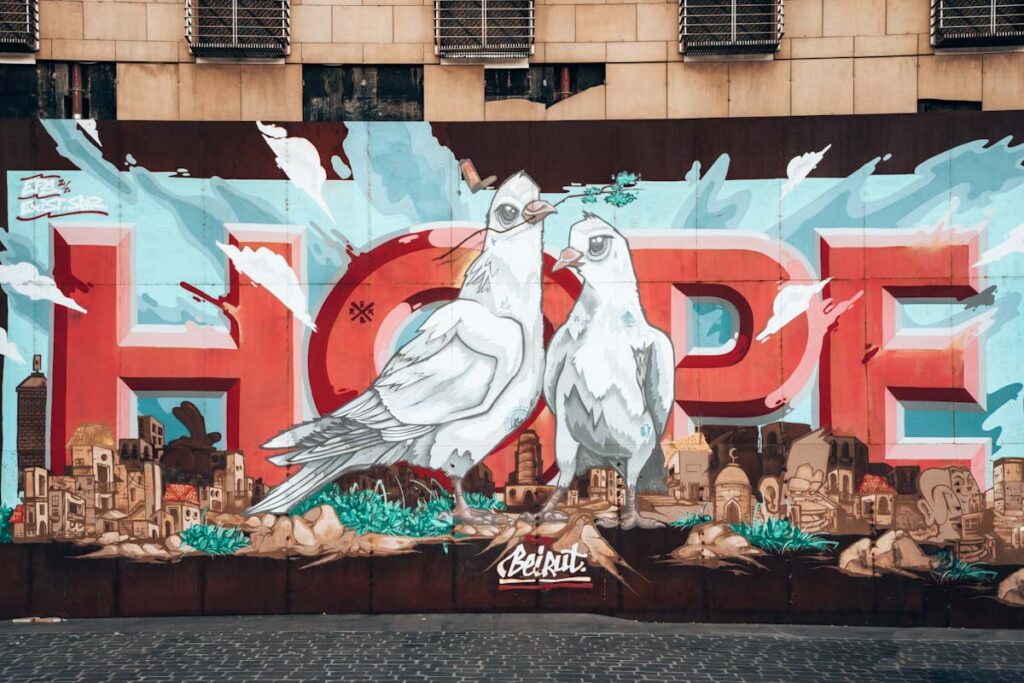
Visa & Covid 19
Most nationalities can get a 30-day free visa on arrival. In October 2022, Lebanon lifted all its Covid 19 restrictions.
Where to do Covid 19 test in Beirut
There are many places where you can do Covid 19 test in Beirut, in case you need one for further travels. We did ours through the American Diagnostic Center for $20. Find the list of places that do PCR and rapid antigen tests in Beirut here.
How to get to Lebanon
We took a flight from Cyprus that took only 45 minutes. Beirut is a pretty busy airport, and many flights come every day. Middle East Airlines and Royal Jordanian are the most typical airlines.
Click here to find your cheap flight.
Food
Food in Lebanon is spectacular. From Falafel, Shawarma, Hummus, and beans to any kind of western food. Make sure to try unique Lebanese sweets.
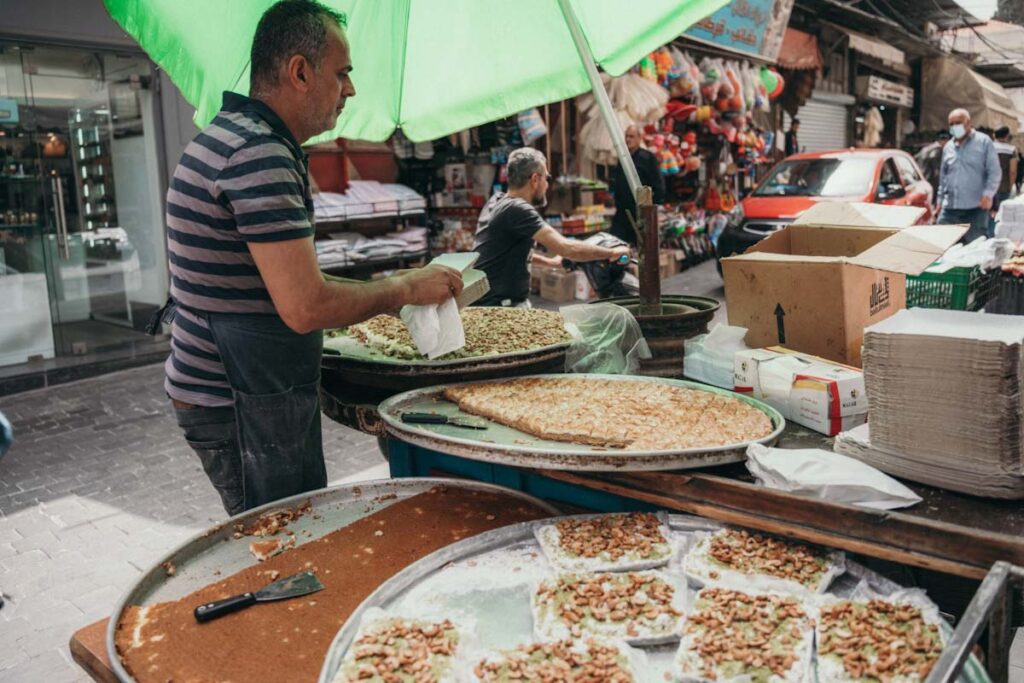
SAFETY
We visited Lebanon in April 2022, when the economic crisis was in full swing, and we got out of the country right before the elections. The situation left many people begging on the streets for money and food. Not only locals but also Syrian and Palestinian refugees. It was such a hard time to see this side of the country, as the number of people on the streets was overwhelming.
We felt safe during the whole time we travelled around the country and didn’t have any troubles. Make sure you read well about the areas to avoid before you travel.
These areas are:
- Beirut: Southern suburbs of Beirut, South of sport stadium
- Tripoli: suburbs of Bab al Tabbaneh, Jabal Mohsen
- Baalbek & Beeka Valley: common area for drug smuggling and the main headquarter of Hezbollah. The city itself is safe.
- South Lebanon: South of Litani river except for Sour (Tyre) because of the unexploded missiles between Lebanon and Israel.
We pay more attention to this topic in a separate article.
Essential reading: Is it safe to travel to Lebanon in 2022?
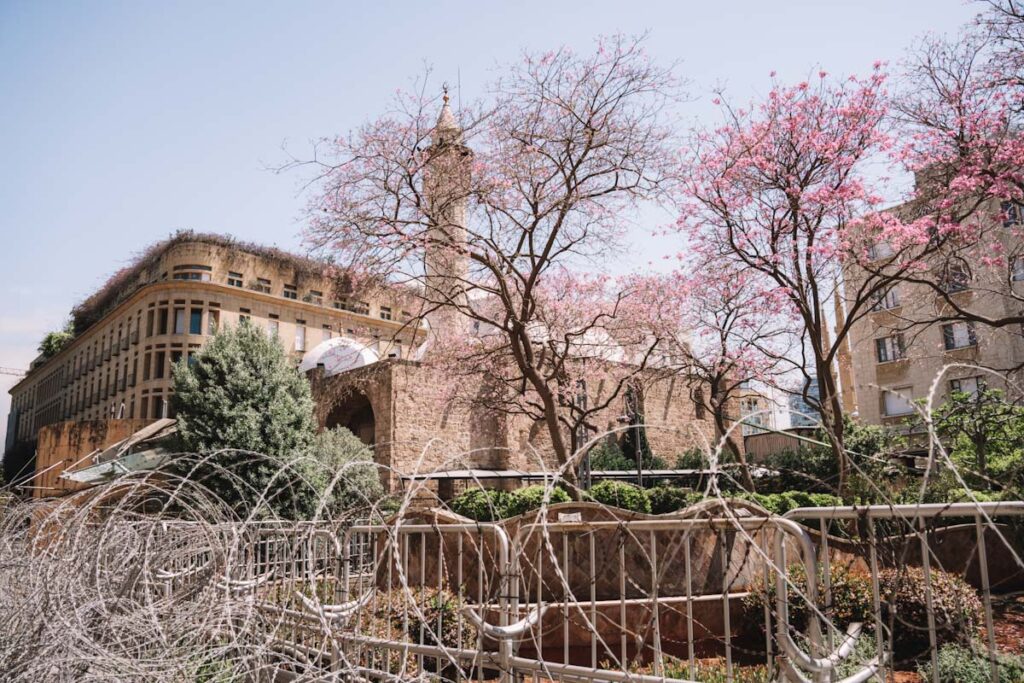
ELECTRICITY
With the current crisis, electricity is a big problem. First days, we tried to figure out the best way to make sure we had our phones charged. Power outages are common. Our hotel in Beirut didn’t have electricity for the first two days. But other than that, for the rest of the stay, we didn’t have any major problems.
Be prepared, the electricity doesn’t work during the night – mostly between 1am to 8am. And for a few hours during the afternoon, usually 3 – 5 pm. Basically, the more you pay for your hotel, the better chance you get of having more electricity. People who can afford it have generators for electricity. People who can’t, sit home in darkness. It is simple like that.
Public lights are mostly not working, so the streets are pretty dark after sunset. However, cafes and restaurants are good for charging things and fast wifi. Make sure you have your charger always with you and charge your phone anytime you have an opportunity.
FUEL
The situation with the fuel is much better than we expected. Currently, it seems it is under control, and petrol is available. Surprisingly, the fuel crisis was much more visible when we travelled in neighbouring Syria.
Essential reading: How to travel to Syria in 2022 & Is it safe?
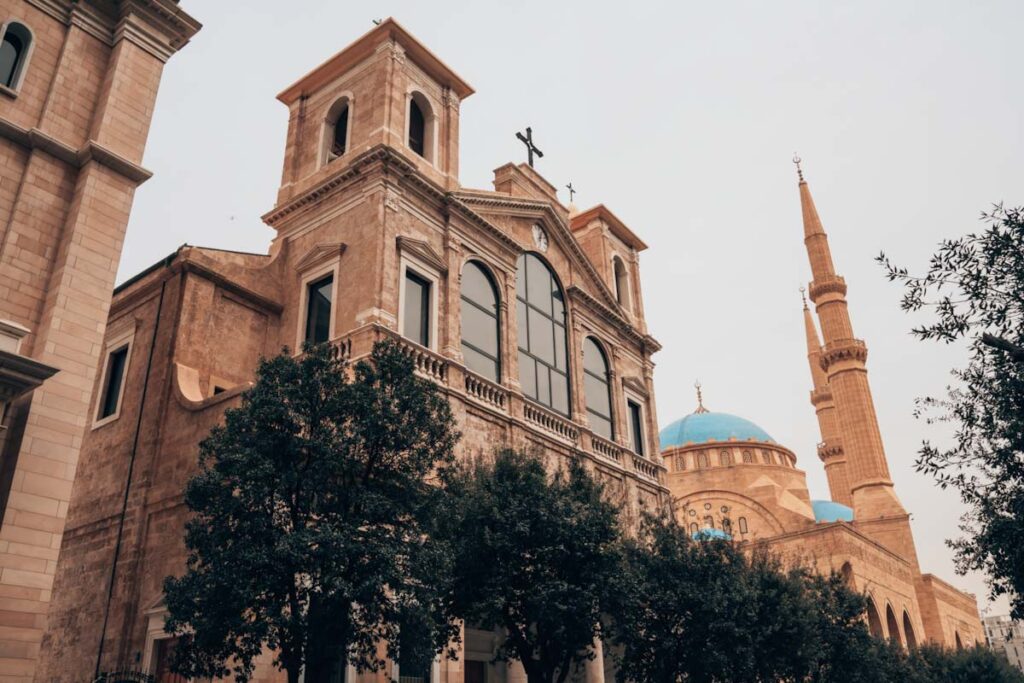
SIMCARD
There are plenty of mobile stores selling local sim cards. The most popular providers are Alfa and Touch. Both work pretty well all around the country and have very good packages with data – up to 100 GB, which is awesome. We picked Touch, 10 GB costs $25, and we got it on Hamra street.
INTERNET
When catching a ride with Bolt or Uber, you need internet on your phone, especially in Beirut, so make sure you have some data. Otherwise, all hotels we stayed in had stable wifi. Even when electricity doesn’t work, they use a battery router, so at least in the lobby or shared room, it works well. Better Cafés and restaurants have good wifi too.
MONEY
You have to exchange the money on the black market as otherwise, with an official rate, you will lose 90% of your money. If you pay in USD, businesses still use an official exchange rate that is ten times higher than the rate on the black market, so make sure you do not pay by card.
The best place to exchange money is on Hamra street. There are many exchange offices. The best is to just walk in a few and ask for their rate.
With an ongoing economic crisis, the rate for LBP is constantly changing. At the time of our visit in April 2022, the exchange rate on the black market for one dollar was LBP 23 500 to LBP 25 800.
Lebanon is the country of cash at the moment. So make sure you bring enough to cover your whole stay. If you pay by a card or withdraw from ATM (they don’t issue any dollars, just LBP), it will exchange based on the official rate, which means you will lose 90%. Don’t do it.
Dollars are the best and easiest to go by, but you can also exchange Euros, and it is actually accessible on the black market too. The rate for €1 was LBP 26 784 in April.
If you run out of money, you can send money through Western Union and pick it up in cash.
Hotels started to charge in dollars, and the rest of the things in Lebanon we paid in LBP.
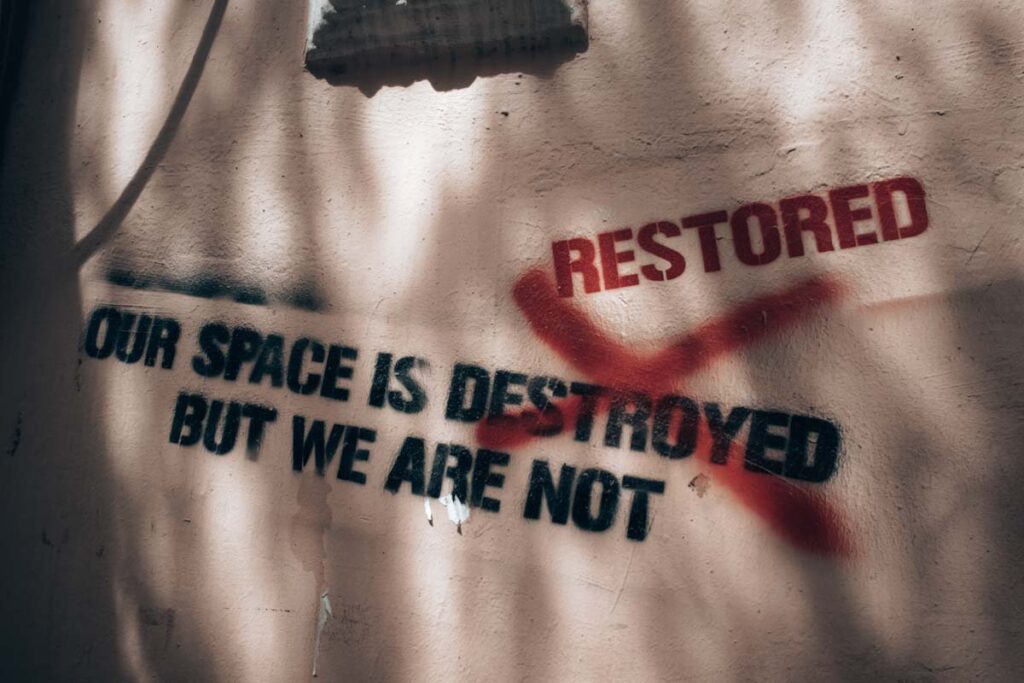
PRICES
The currency in Lebanon is the Lebanese Pound (LBP). In April 2022: $1 = 24 000 LBP
Coffee – LBP 7000 ($0,3)
Falafel – LBP 35 000 ($1,5)
Bolt ride – LBP 40 000 ($1,7)
Water 1,5L – LBP 7000 ($0,3)
Bus between cities – LBP 50 000 ($2)
Hummus – LBP 30 000 ($1,25)
Lunch in local restaurant – LBP 40 – LBP 100 000 ($1,6-$4)
Street food snacks – LBP 20 000 ($0,8)
INSURANCE
Make sure to have travel insurance with good coverage, especially in countries like Lebanon, where many governments advise against all the travel. One of the little providers on the market who covers Lebanon, including Covid-19, is IATI Insurance. We have a 5% discount for Broken Navigation’s readers.
Get your 5% discount with IATI Insurance.
HOW TO TRAVEL AROUND BEIRUT
Travelling around Beirut is very easy and convenient. Even though there is no public transport, there are three options.
- Bolt – the number one app. It works the same as Uber but is a bit cheaper. We never waited for a ride longer than 5 minutes. It is safe, cheap and fast. The ride within a city costs around LBP 32 000 – LBP 55 000 ($1,2-$2).
- Uber – another convenient option. We personally always used the Bolt, but we know Uber works well too.
- Taxi – just wave on a taxi by the road, and they will pick you up. The prices are similar to Bolt or Uber, but sometimes it can be tricky to communicate where you want to go if the driver doesn’t speak English.
All the service cars meant for transportation of people have a red plate, or the numbers on the plate are red. Make sure you don’t get in a car with a different plate colour as it means they are not official. It applies to all – Bolt, Uber, Minivans, Buses, taxis…
Many people also use the services of local guides and tours, which take you to places difficult to get by public transport. We met more travellers using these services, and if you have less time and want to see more, or simply don’t want to worry about transportation, it is the perfect option for you. You can find many exciting tours here.
Find the local guide for your trip here.
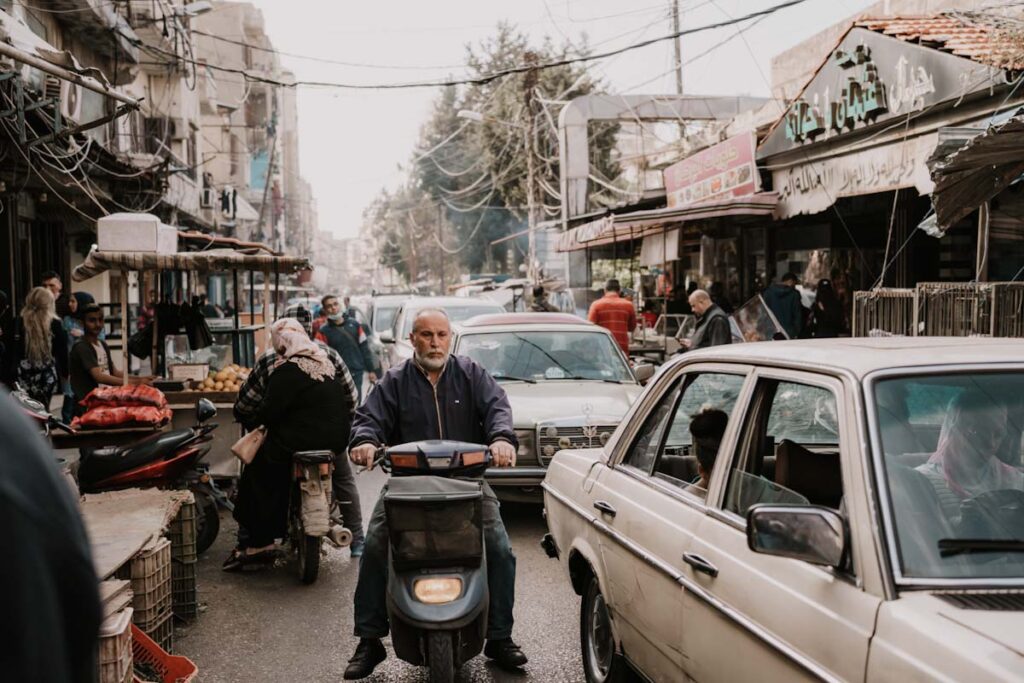
PUBLIC TRANSPORT
There are two main bus stations – Cola and Dawra. After the explosion in the port in 2020, the Charles Helou station doesn’t work anymore.
- From Cola intersection: Saida, Tyre, Baalbek, Zahlé
- From Dawra station: Byblos, Tripoli, Batroun
- A fast option to Tripoli (Byblos, Batroun): go-to station on Martyr’s square from where big Connexion buses running
- To Bcharré: Estephan Transport company run buses from the little roundabout near Dowra.
Bus Schedules
Except for a few routes with a fixed schedule (mentioned below), buses leave once they are full. It is actually a brilliant and convenient way of travel, as it means there are still busses running. Once one is full, another one is immediately waiting for its passengers. Mostly, the drivers don’t wait to be completely full. They just go when they want to. We never waited on the bus for more than 20 minutes.
PLACES TO VISIT IN LEBANON & 11 DAYS ITINERARY
The following can serve as an itinerary as the places are mentioned in the order we visited them.
DAY 1-2 BEIRUT
Beirut, as a capital, has a lot to offer. The city and its people went through so much in recent years, from the civil war and explosion in the port in 2020 to a recent economic crisis that affected a whole country.
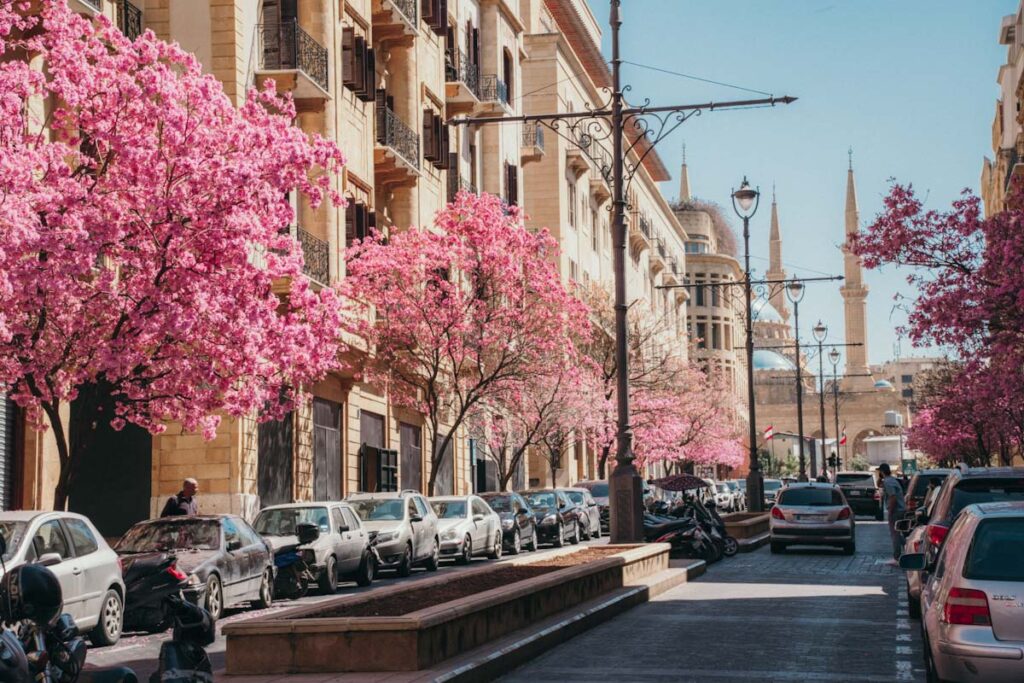
When we arrived, the first impression was quite weird as there were so many destroyed buildings and barricades in the city centre. Now we already know this is a style that Lebanon keeps for purpose. The old destroyed buildings by war serve as a reminder of old horrific times. Also, Lebanese thinks that’s a cool kind of art, so it is just something different from what we are used to, but after a day of wandering around, we didn’t even pay attention to it anymore.
Beirut is a more western city rather than the Middle East experience you might be expecting here, with different parts of the town all very different from each other.
Hamra street is a busy street full of exchange offices, restaurants, cafes, and mobile shops and basically, all you want to buy is here. Gemmayzeh and Mar Mikhael are known for hipster cafes and restaurants. Recently life is going back to normal after the explosion destroyed a big part of this street. Rue Armenia, as the name suggests, is an Armenian part and don’t forget the Corniche, a seafront that is always busy with locals and tourists.
Read more: Detailed city guide to Beirut & Top things to do in 2022
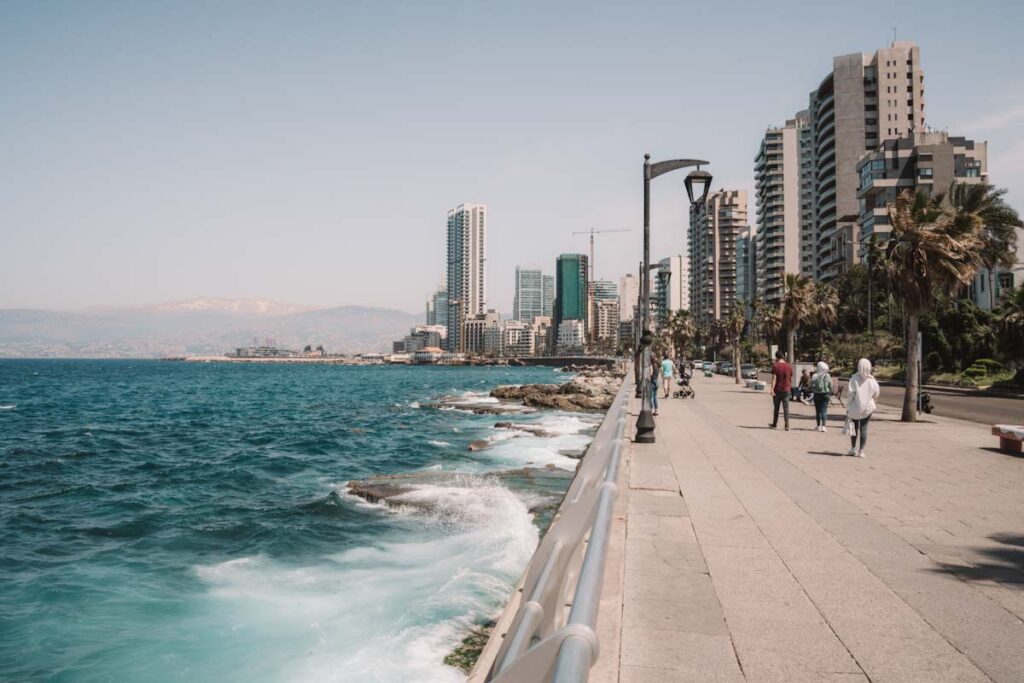
Among the best places to see is, without a doubt, the biggest mosque in the Middle East, Pigeon Rocks and the Egg, and we loved the contrast of the church being right next to the mosque.
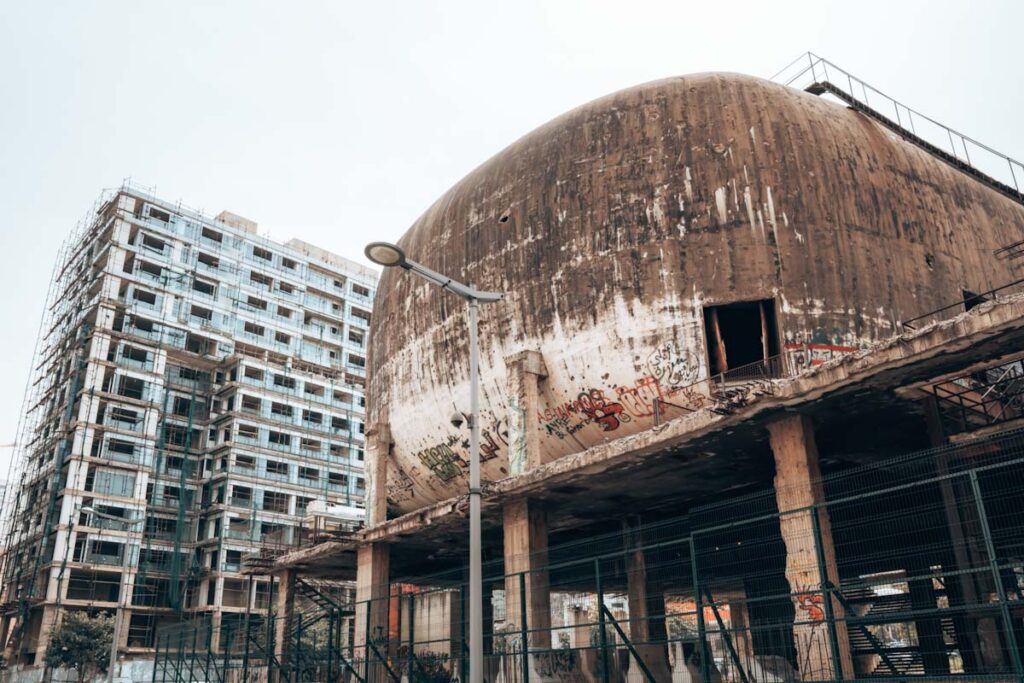
WHERE TO STAY IN BEIRUT
We would like to quickly mention that since Lebanon is going through one of the biggest economic crises. Electricity does not work everywhere, and the same applies to hotels. Many of the budget and Mid-Range hotels are either completely disconnected from electricity or rely on the government supply that usually lasts around 2 hours. Make sure you do your research before you come.
Budget I Regis Hotel – we stayed here. The price is very good for what you get. The location is in a good, clean neighbourhood close to Zaitunay Bay and 1 km from Hamra street. There was hot water, and our room had a nice balcony. We paid $20. The guys running this hotel are absolutely amazing and, beyond words, helpful. We felt like at home during our whole stay, and if we ever come back, we will stay here again.
Mid-Range I Bossa Nova Beirut – the location and price of this hotel is exceptional. There is a rooftop pool and a garden, so it makes a perfect place to relaxing after a long day of exploring. The views are exceptional.
Luxury I Sodeco Suites – The piece of luxury in the centre of Beirut. There is everything you might need. Breakfast is included as well as a fully equipped kitchen.
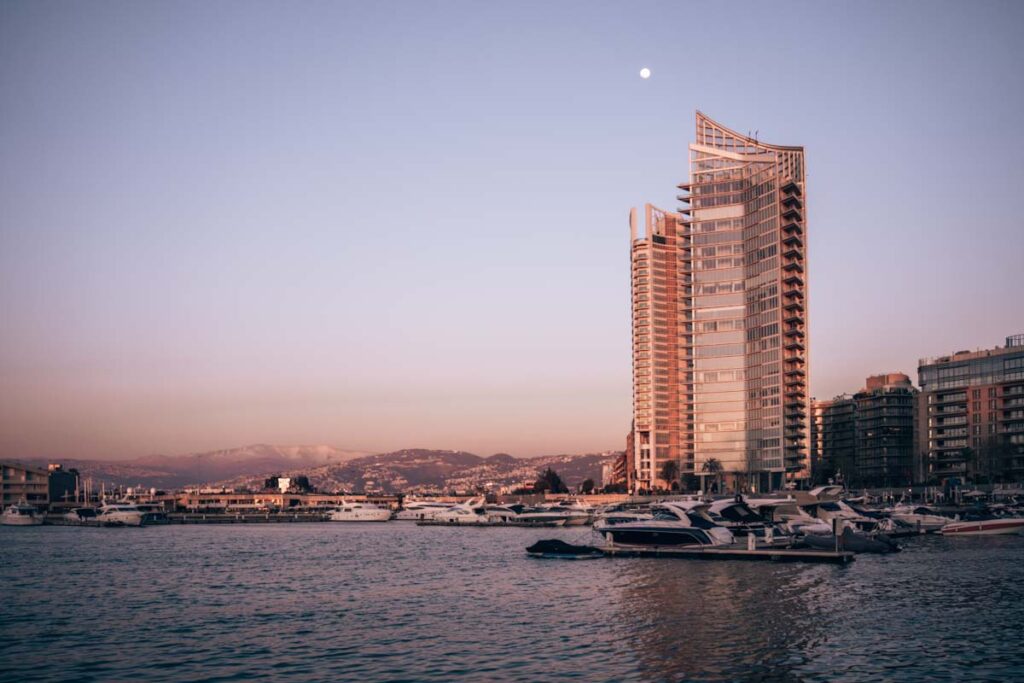
WHERE TO EAT IN BEIRUT
Many restaurants are especially in the Gemmayze district, and Hamra street has many street food options.
Le Chef – a traditional, family-owned restaurant with a handwritten menu of the day. The food is amazing, and the prices are cheap compared to other restaurants in the area. Sometimes you have to wait for a table as this place gets crowded. It is located in the Gemmayze district.
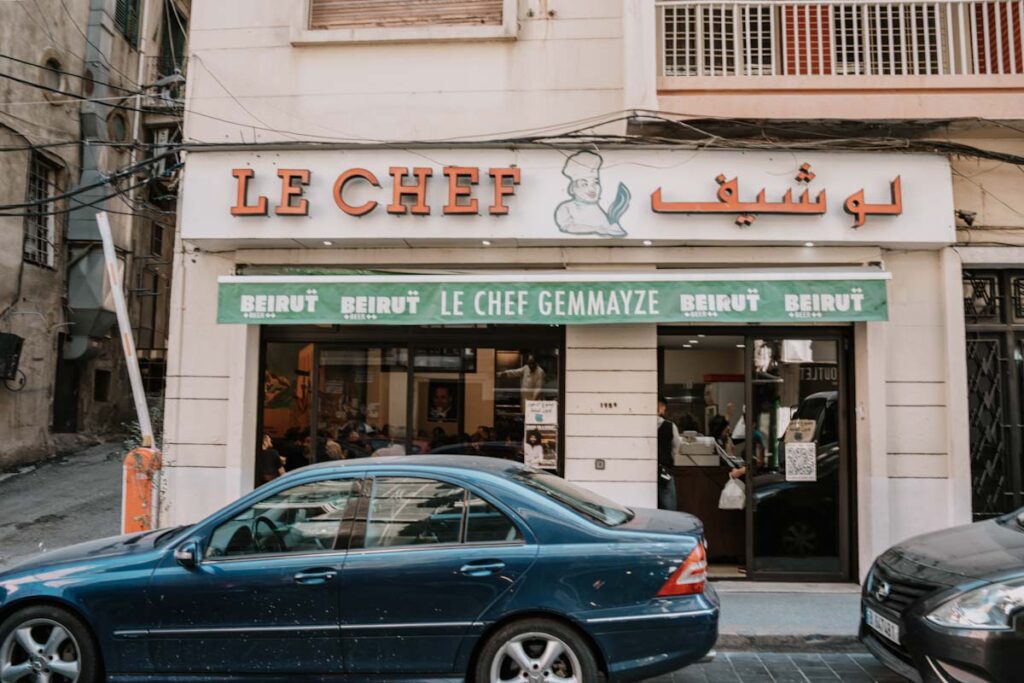
DAY 3 SAIDA (Sidon)
Saida is a Sunni Muslim city, which surprised us with how different from Beirut it is. Saida is more conservative than other cities, so you should dress accordingly. It is a city where you can spend hours wandering around its bustling market. Looking back, Saida was one of our favourite places to visit.
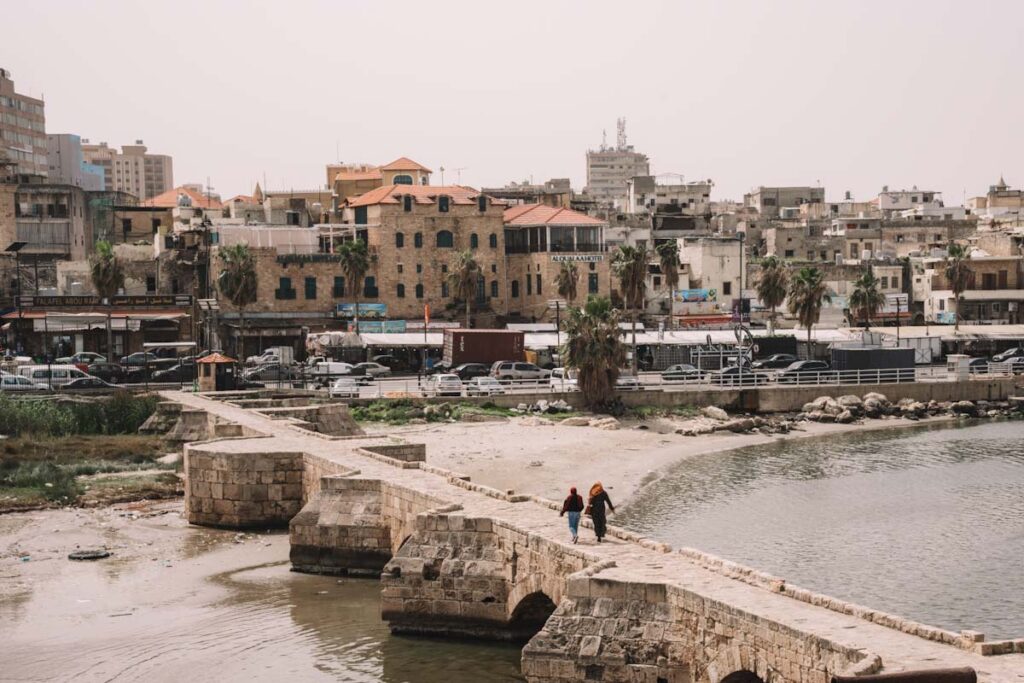
WHAT TO DO IN SAIDA
Souk
We fell in love with the souk. It is actually the most authentic one, together with the one in Tripoli, that you can find in Lebanon. There are many small passages where you can just wander around and enjoy the atmosphere of this bustling souk. Make sure you try some sweets as Saida is well known for its delicious cookies.
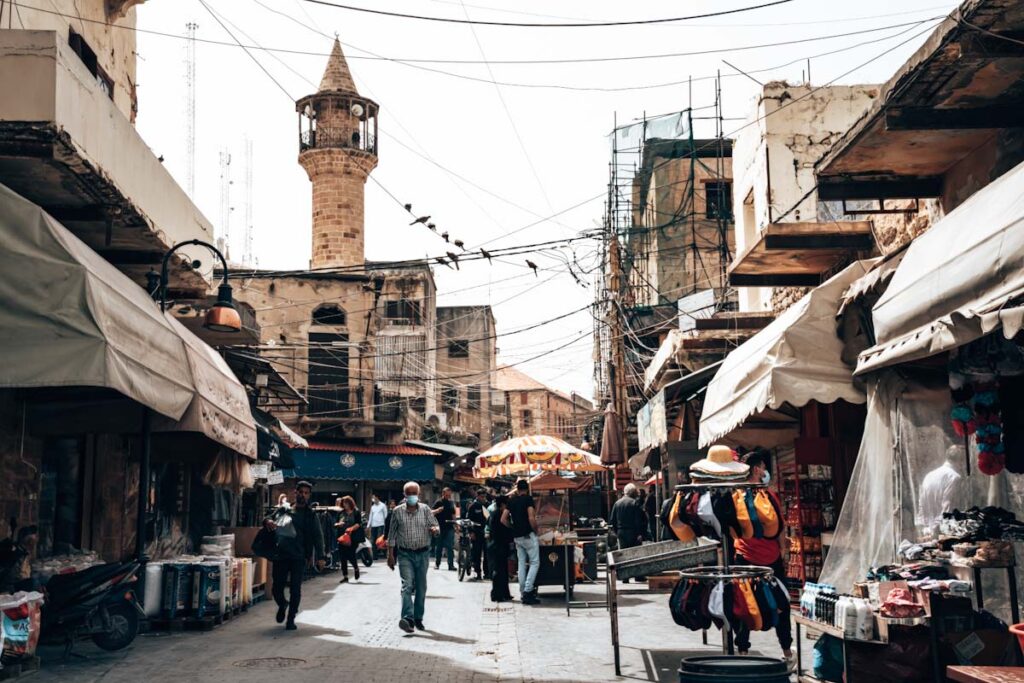
Saida Sea Castle
Crusader castle that is nestled on the sea. A beautiful pathway leads you to this little castle surrounded by sea. It was built in 1228 and later renovated. You also get a nice view of the city from a different perspective. Entry LBP 4 000 ($0,17).
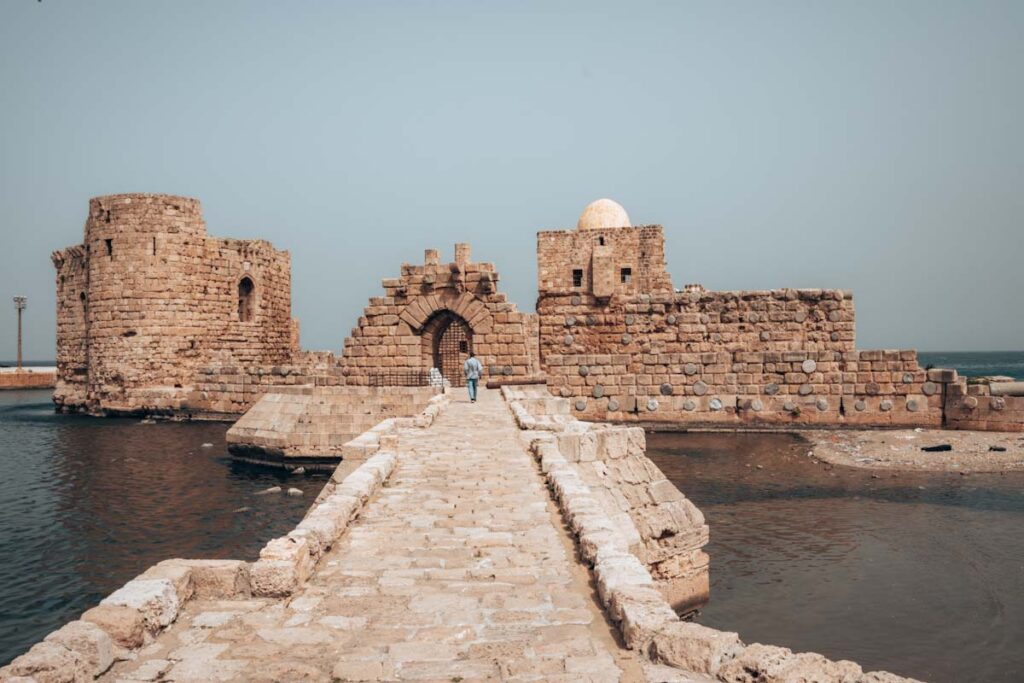
Bab Al-Serail Square
Perfect place to sit down and just observe what is going on. There is a mosque, restaurants, stores, and cool decorations worth visiting. It is located inside the old city, so it is easy to find it.
Since we visited Lebanon during Ramadan, all restaurants on this square were closed. So, unfortunately, we didn’t have a chance to try any of their food, but if you arrive at a different time, you will have plenty of options to choose from.
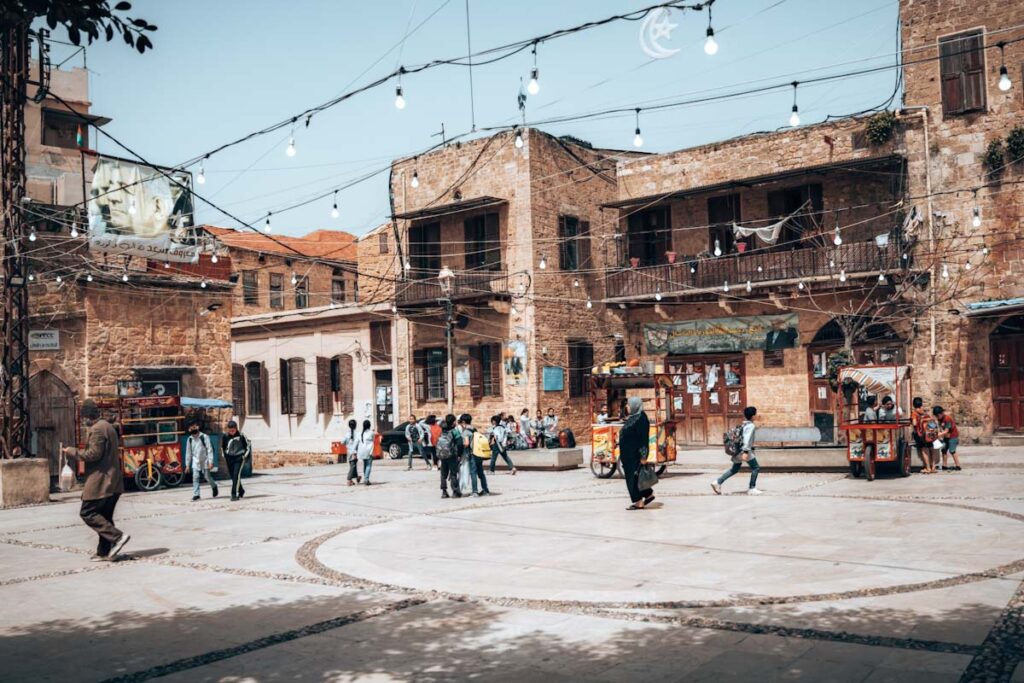
HOW TO GET FROM BEIRUT TO SAIDA (SIDON)
Buses, minibuses, minivans or shared taxi to Saida leaves from the Cola intersection. It is a bustling station, where everyone is yelling the bus destination, so just ask around or listen carefully.
The price for a minibus is LBP 20 000 ($0,85). For a shared taxi, LBP 30 000 ($1,2) and the ride takes between half an hour and an hour and 15 minutes and drops you off on Nejmeh Square, a big roundabout very close to the old town. The fastest option is to take a big bus in Cola that goes directly to Saida and takes only half an hour. LBP 30 000 ($1,2).
To get back from Saida to Beirut, buses leave from Nejmeh Square. Again, you can choose from the big bus, minibus, minivan or shared taxi. The best option is the big bus as it doesn’t stop along the way and takes only 30-40 minutes to get to Beirut Cola station.
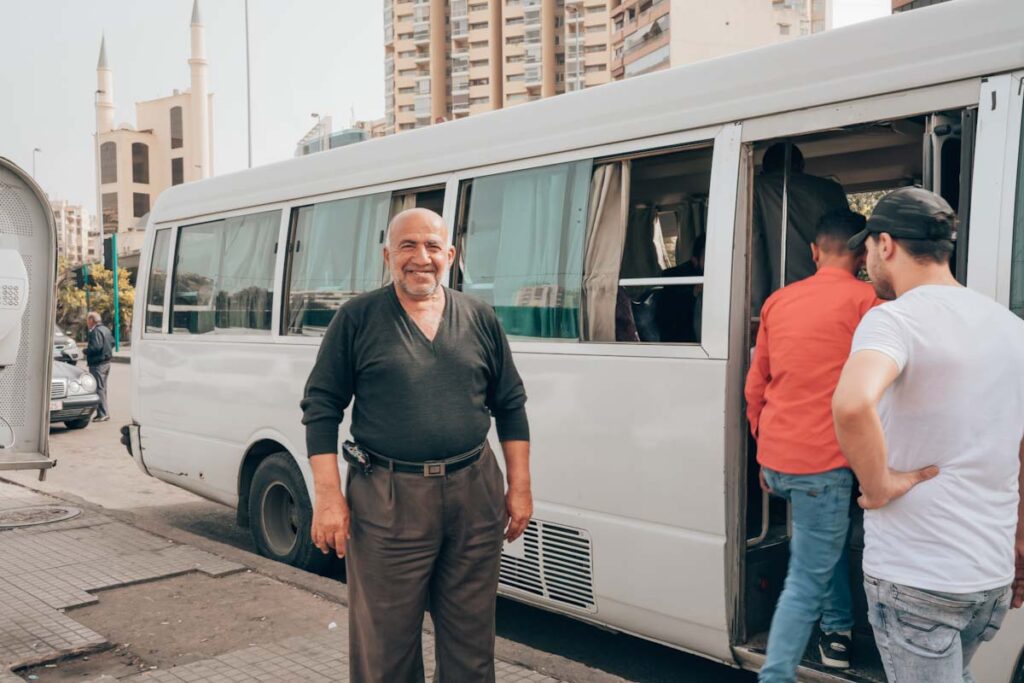
WHERE TO STAY IN SAIDA
There is almost no accommodation in Saida. Actually, we found only one hotel that is currently open. We visited Saida on a day trip from Beirut, and most of the travellers do the same as it is the most convenient way. Anyway, if you would like to stay overnight, check Saidon Hostel.
Budget I Saidon Hostel – the only cheaper option; however it comes with a con. It is located 6 km’s from the city centre. They offer a free pick up.
Where to eat in Saida
Make sure you try falafel in the family-run charming eatery Falafel Abou Rami, where Abou Rami has served his crispy falafel himself since 1988. It is in the corner opposite the Saida Sea Castle.
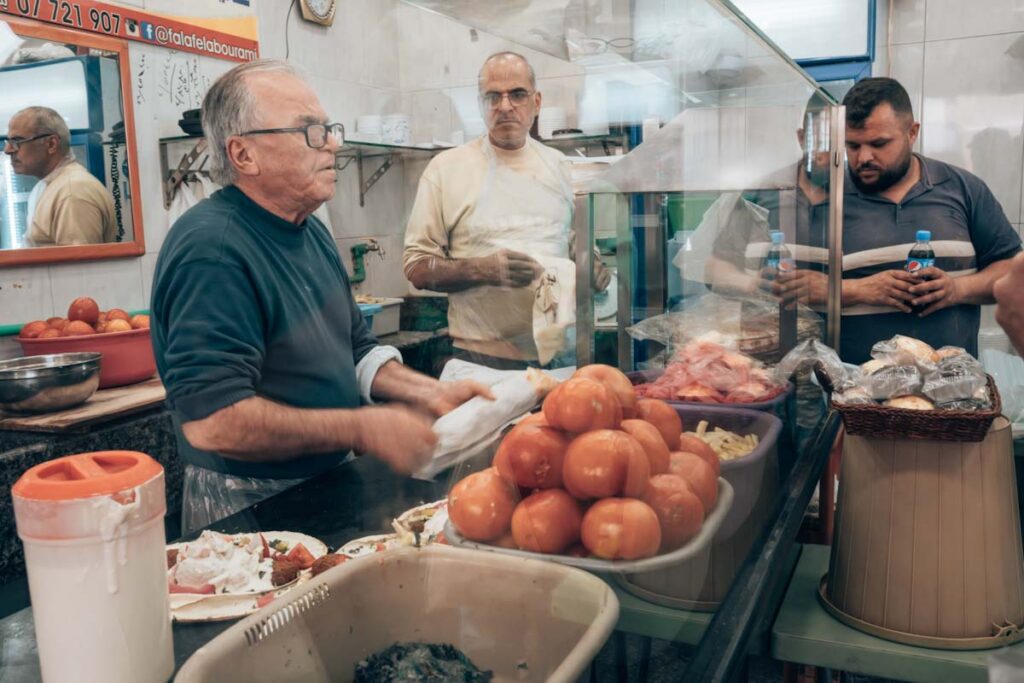
DAY 4 SOUR (TYRE)
Shiite town Sour (Tyre) is located 80 km south of Beirut. You find here the power base of Hezbollah’s Secretary-General and UN peace-keepers.
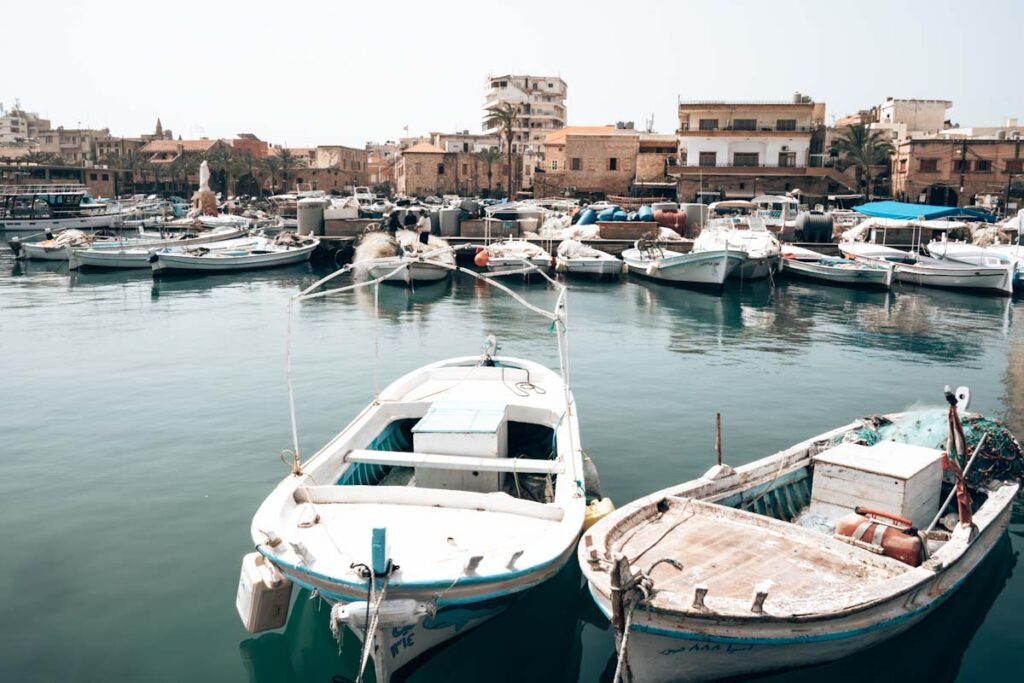
What to do in Sour (Tyre)
We liked Sour’s amazing mixture of different cultures living next to each other. At one moment, you walk through the bustling souk, and suddenly you find yourself in a port, with seafood restaurants reminding us of France. This is all within a short walk through the old part of the town.
Tyre is known for the archaeological sites of Phoenician ruins that brought Sour into the Unesco world heritage list. The city has a rich history. It was colonised variously, for example, by the Assyrians, Romans, Byzantines, Crusaders, Arabs and Ottomans.
Walkthrough the Christian quarter that starts behind the port. You can visit a beautiful church, walk through colourful narrow streets, and see a promenade along the wild sea once you walk out of the Christian quarter.
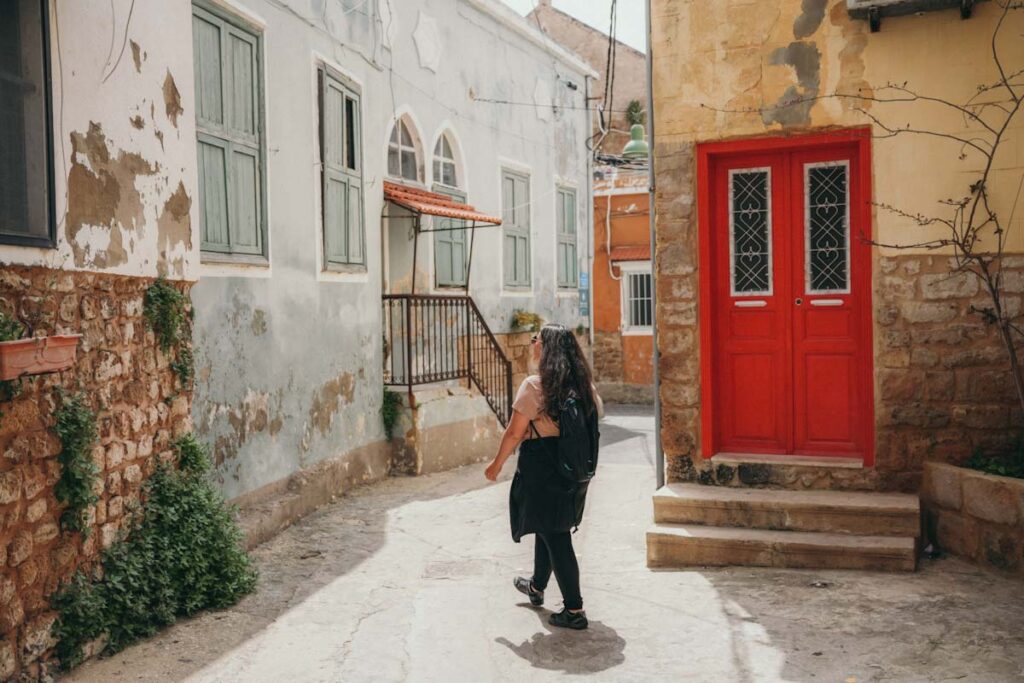
HOW TO GET TO SOUR
The buses or minibuses leave from the Cola intersection. The best is to take a big bus from Cola station to Saida (LBP 30 000), which takes around 30-40 minutes, then change a bus in Saida to a minivan to get to Sour (LBP 30 000). The bus in Saida drops you off at Nejmeh square. You need to walk 200 m to the Sidon bus stop by the sea, next to the Cafe Nour. The bus takes from one to two hours; the times vary greatly. On the way to Sour, it took us one hour but on the way back one hour and a half.
To go back from Sour to Beirut, get a minibus going from Tyre Bus station in the city centre, the same place they dropped you off before.
There is also a direct minivan from Beirut Cola station to Sour, but we heard this can take up to three to four hours since they stop frequently.
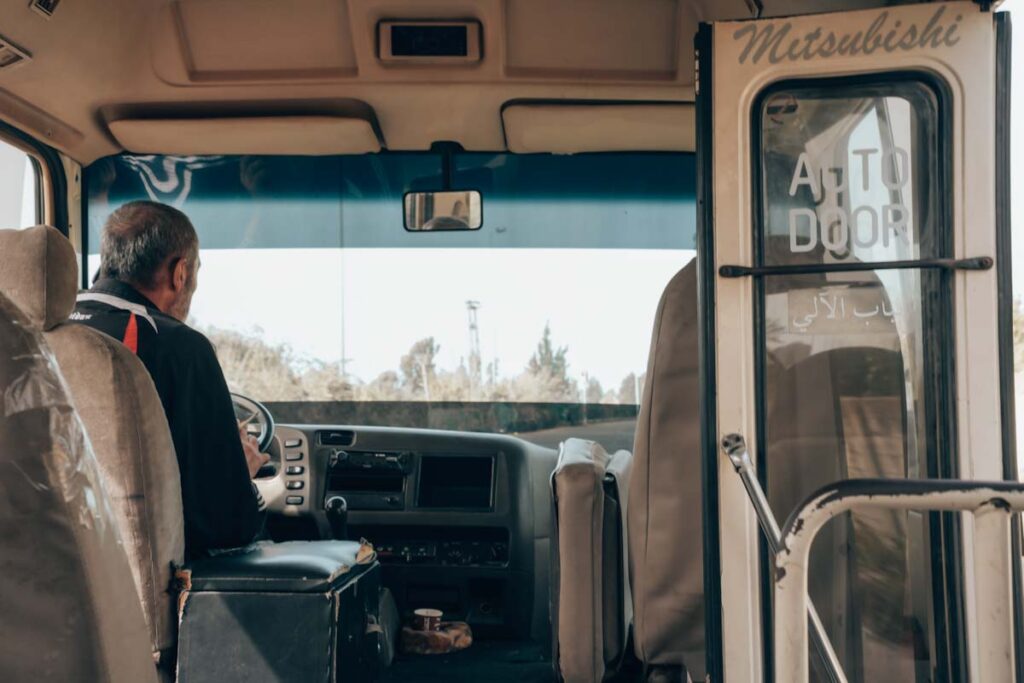
WHERE TO STAY IN SOUR
Sour is a perfect day trip from Beirut. Since the accommodation is very expensive, we opted to go back to Beirut for a night. If you feel like staying, you for sure will have a great time. The hotels are located in a Christian part, and most of them have a beautiful sea view. Those are the best options in the area:
Mid-Range I Dar Camelia – Possibly the most beautiful and stylish place to stay overnight in Tyre. The design of the rooms, garden and breakfast all are made with love, and you can tell from all the details.
Luxury I Dar Alma – Beautiful accommodation is in an old part of the city. Make sure you ask for a room with a balcony overlooking the sea. Breakfast is included.
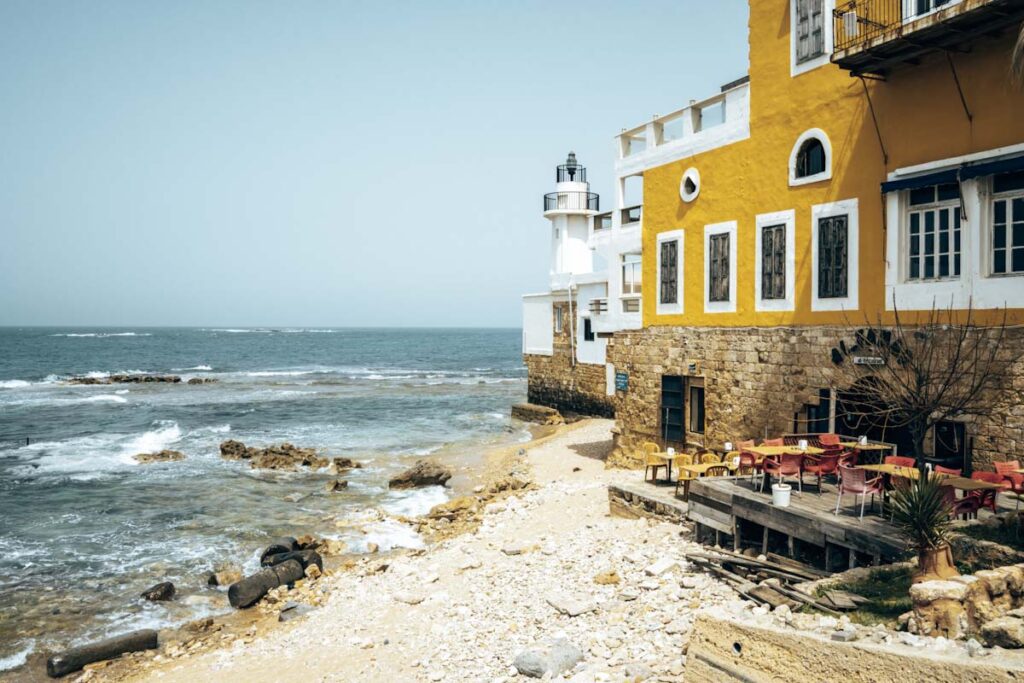
DON’T GET OFF THE BEATEN TRACK IN SOUTH LEBANON
The area south of Beirut, including Saida and Sour, has an unfortunate history. It is a usual target for missiles from Israel; therefore, wandering around nature outside the cities is not recommended as there might be unexploded missiles. There is nothing to worry about in the city; it is a popular holiday destination for Beirutis.
Also, make sure you check the current safety situation before going to this part. At the time of our visit in April 2022, everything was fine.
DAY 5 BYBLOS (JBAIL)
Byblos is a touristic city with a Christian population located 40 km north of Beirut. Once we got to Byblos, the city inhabited since 7000 years ago, we felt like this couldn’t even be Lebanon. It was like being back in Cyprus. The old town is very picturesque, and we felt really great wandering around its stone, vintage streets. However, we visited Byblos in April, when it was off-season, and the city was quite empty. We can imagine how unpleasantly busy it can get during summer. No wonder, as the restaurant & bar scene here is bringing crowds.
What to do in Byblos
Crusader Castle
The most visited archaeological sight is a crusader castle located right in the middle of the old town. It offers a perfect mixture of Neotholic, Chalcolithic, Greek and Roman ruins. You also get a beautiful view over the port. The entry fee if LBP 8000, and it is open from 8am to 6:30pm.
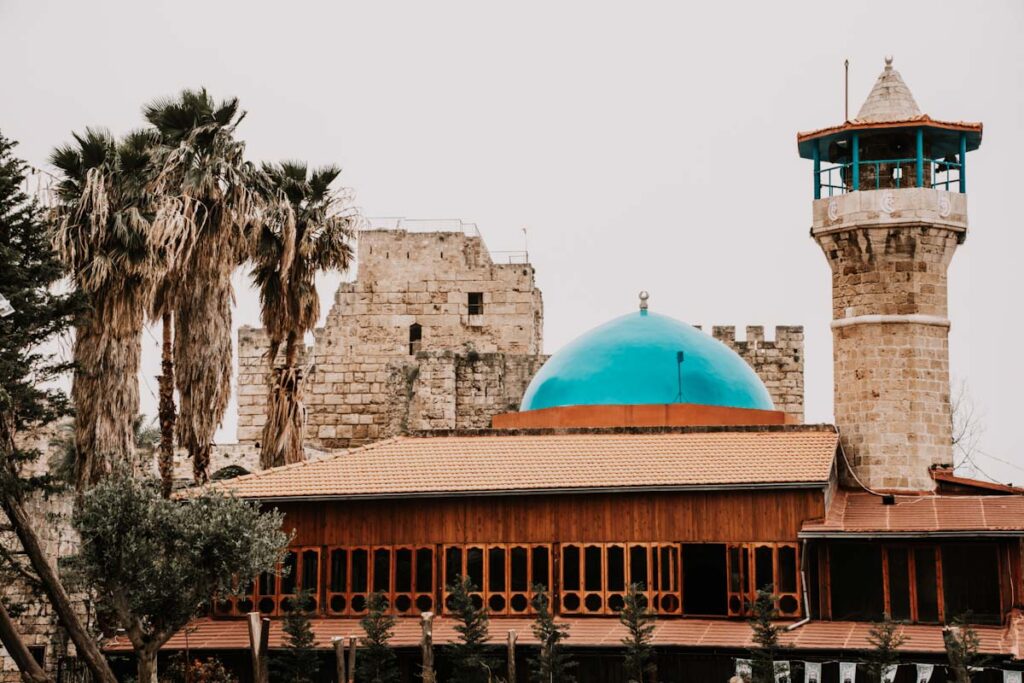
Church of St. John Baptist
Breathtaking Romanesque church from the year 1115 a.c. It is usually closed to get inside, but it is amazing from the outside. There are beautiful glass mosaic pictures outside of the church that you can admire.
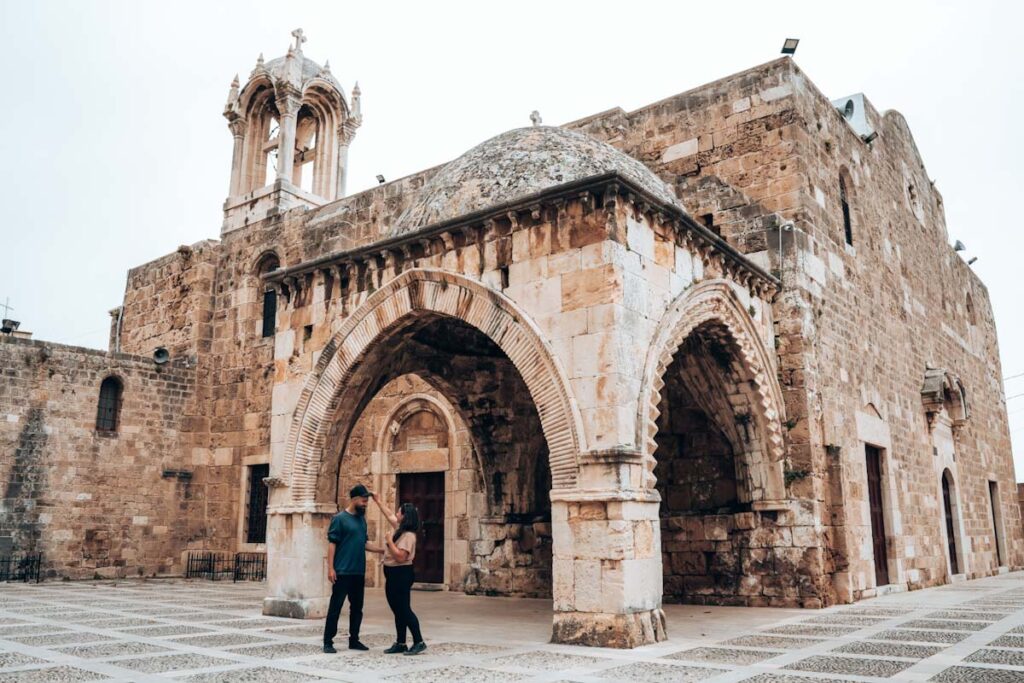
Museums
There are many interesting museums around Byblos. In the city centre, you can find a wax museum or a bizarre museum featuring silicon figurines of controversial politicians, leaders etc., that is located right in the centre of the old town.
Fishing port
From the city centre, you can walk to a beautiful fishing port with an ancient harbour with pretty wooden boats. Many restaurants and hotels are around, but the promenade is still relatively empty in April. You can get a view of the town from a different perspective.
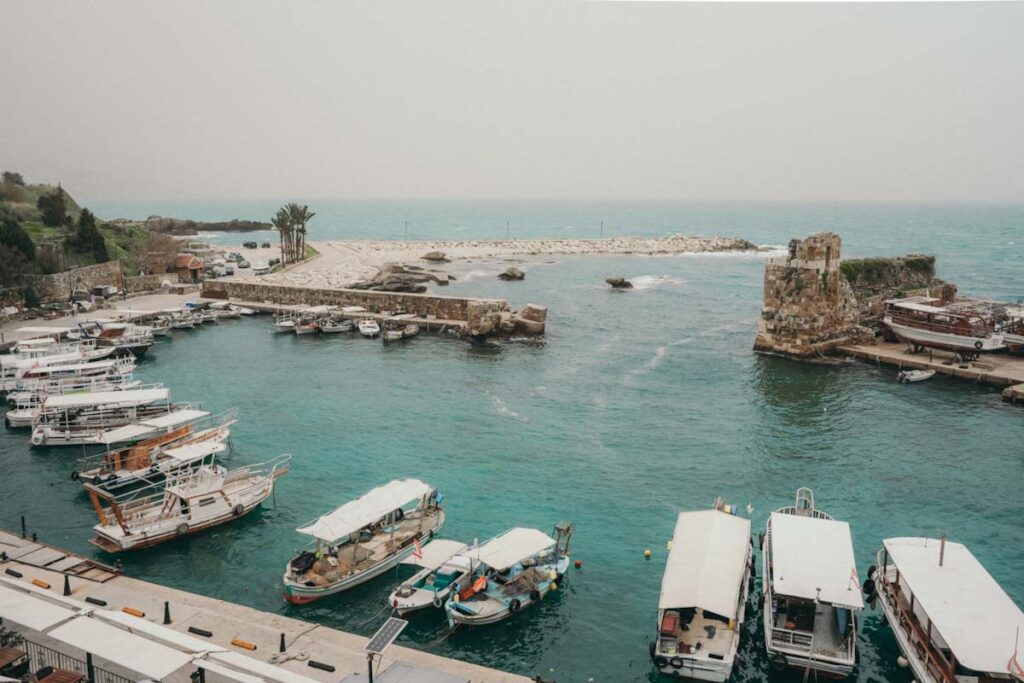
Where to eat in Byblos
There is an amazing eatery where locals gather called Rock. They serve shawarma, falafel, batatas harra and many other traditional Lebanese food. It is located on the way from the bus to the old town.
How to get to Byblos
Minibuses are leaving from Dawra station in Beirut (LBP 25 000), and it takes 50 minutes to get to Byblos. The bus drops you off at the main intersection, where you easily walk to the city. The old part is roughly 5 minutes walk.
To go back to Beirut, go to the same intersection, just from the other side of the road. Buses are waiting there to go to Beirut.
WHERE TO STAY IN BYBLOS
It is effortless to come for a day trip with an overnight in Beirut; that’s what we did. We are sure though, if you want to stay a night in Byblos it will be a pleasant experience, especially if you’re going to enjoy cafes & bars in the old part. And you can find pretty good deals for hotels.
Budget I Byblos Guesthouse – the cheapest option in Byblos. The rooms are spacious and clean. However, you need to walk or take a taxi to the city centre 2 km away.
Mid-Range I Monoberge Hotel – if you want to stay in the city centre and 2 minute walks from the beach this hotel is a perfect option. It is a popular place with a good breakfast included.
Luxury I Maximus Hotel – the piece of an absolute luxury. Maximus hotel features an outdoor swimming pool, fitness centre and delicious breakfast. The views are magnificent, and it is a perfect resort if you search for this kind of stuff during your travels.
DAY 6 TRIPOLI (TARABULUS)
The second-largest city in Lebanon. In Tripoli, you find the Sunni population and the best souk in the whole country. It is necessary to check the safety situation before travelling to Tripoli, as there are issues between the two districts, where guns are often used. Even though most governments advise against the travel to Tripoli, the conflict doesn’t go further than in the areas of Jebel Mohsen and Bab Al-Tabbaneh, and it doesn’t affect tourists. With a frequent military presence on the streets, we felt very safe.
Tripoli is a traditional city north of Beirut, especially famous for its sweets and labyrinthal souk, where you can get lost for hours. If you want to learn Arabic, it is a perfect base with some pretty good Arabic course options for foreigners and volunteering options; check Levantine Institute of Tripoli for more details if this interests you.
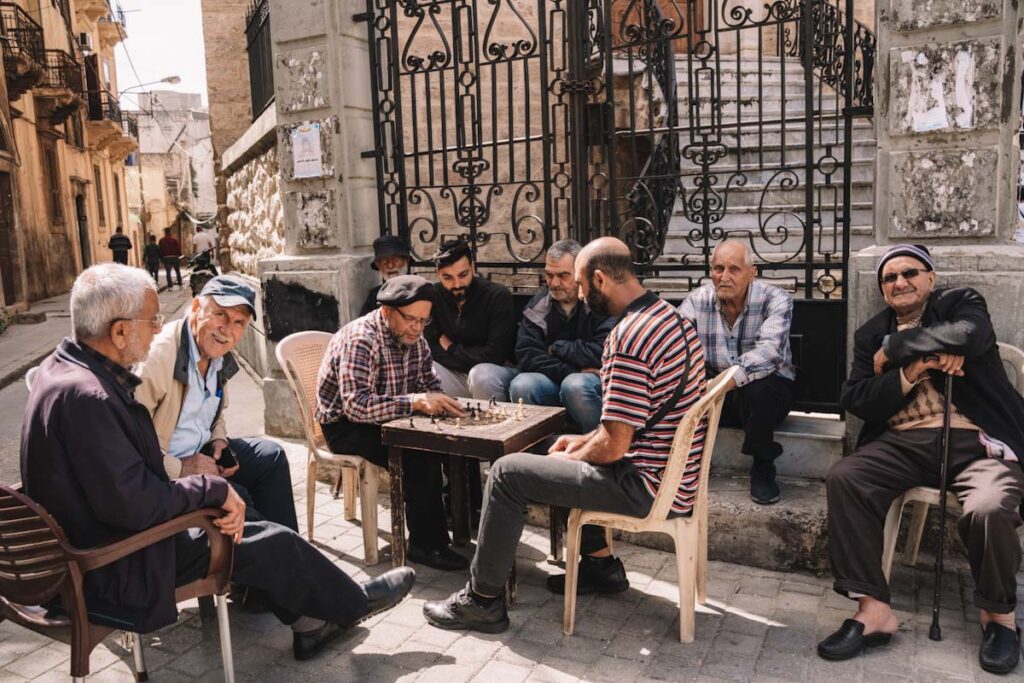
What to do in Tripoli
There are two main areas to explore. The old city is rich in history and great for seeing Ottoman and Crusader architecture examples. Al-Mina is a new part, where all the bars and modern restaurants are located very close to the harbour.
Citadel of Raymond de Saint-Gilles
Impressive Crusader fortress built in 1104 a.c., with an active military base inside, yet still open to the public. Even if you are not a fan of history and citadels, it is with it to come at least for an impressive 360 view over the city. It is open from 8 am till sunset, and the entry fee is LBP 7500.
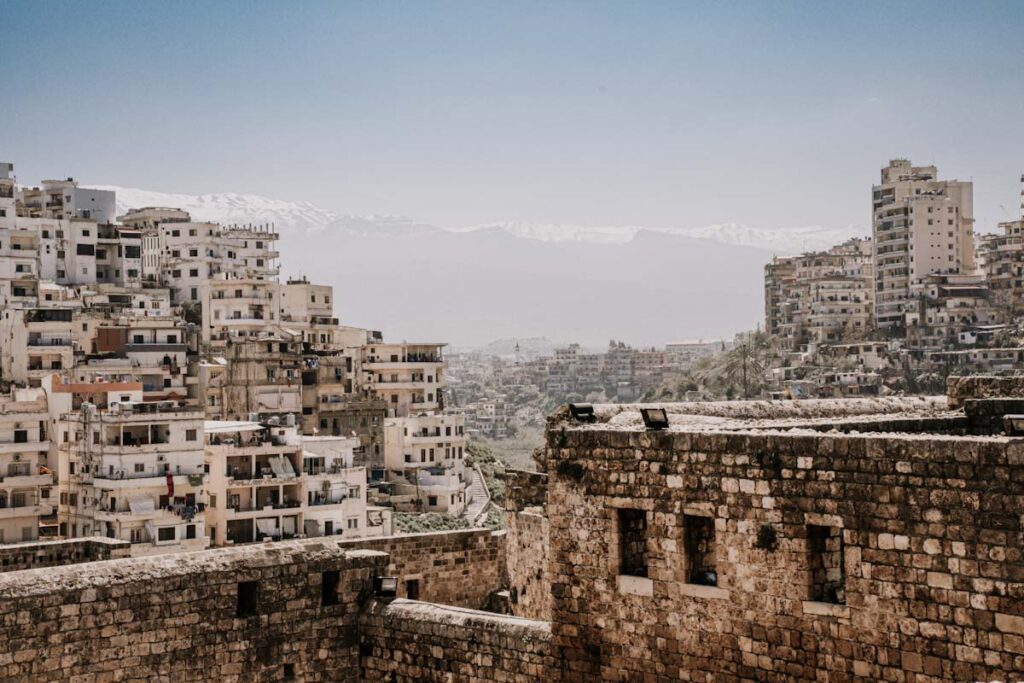
Souk
The biggest souk in Lebanon from the 14th century is the best part of any visit to Tripoli. Narrow streets full of vendors selling everything from clothes to delicious food. Visit hammams, mosques or madrassas.
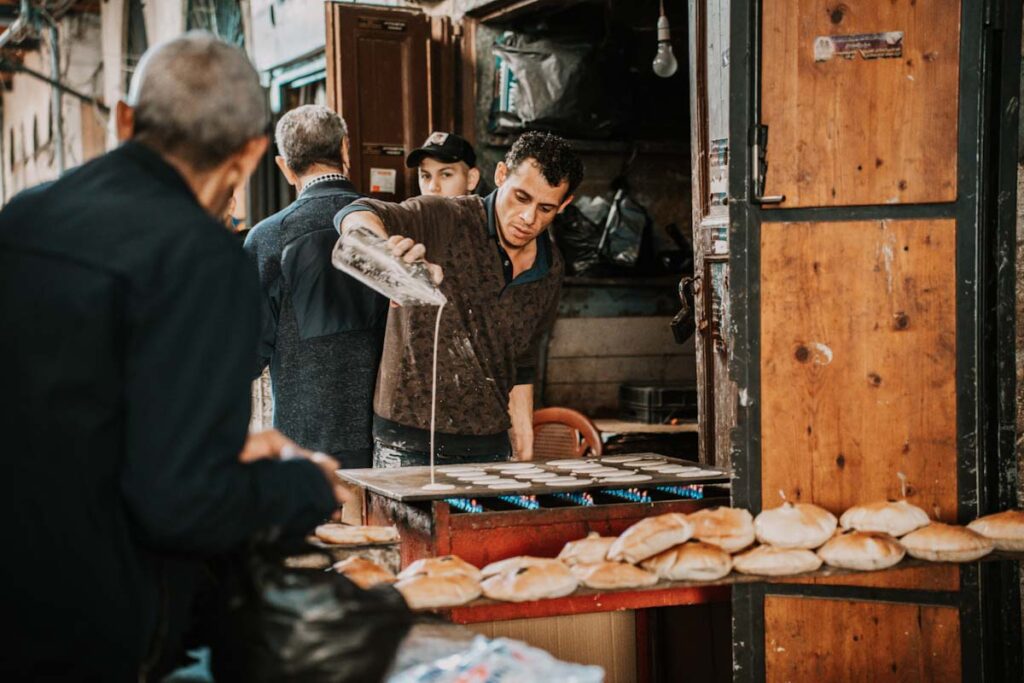
Traditional soap factory
A small family-run company making soap. There is not that much going on, but it is worth a visit as the place feels really authentic and traditional.
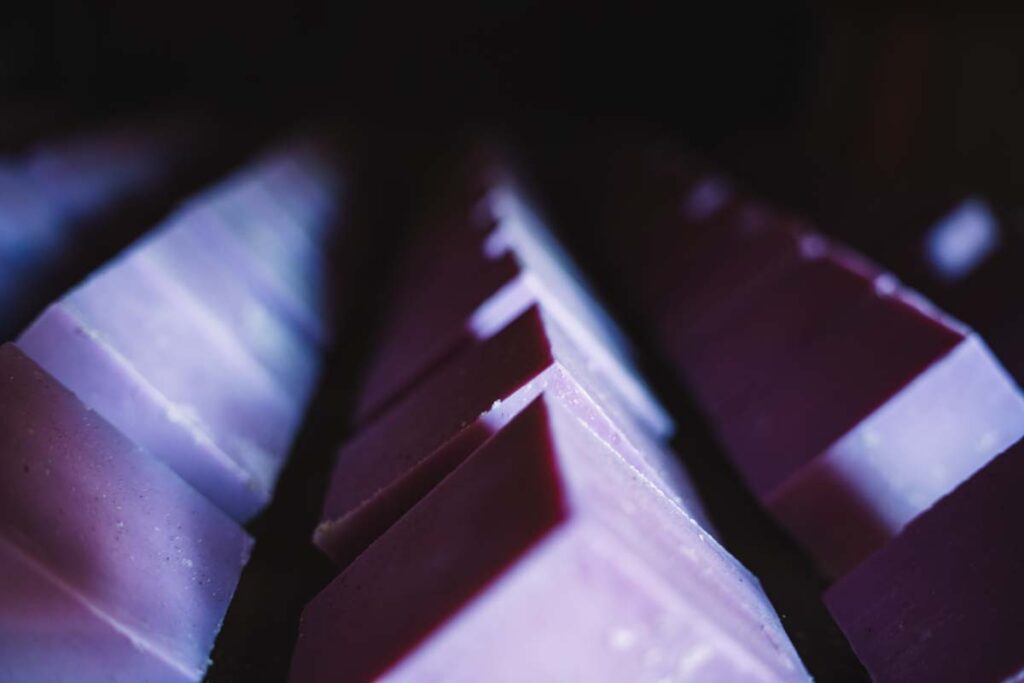
Great Mosque
Located in the heart of the old centre, it attracts visitors for its beautifully decorated entrance and an unusual minaret that is believed it once served as a cathedral bell tower.
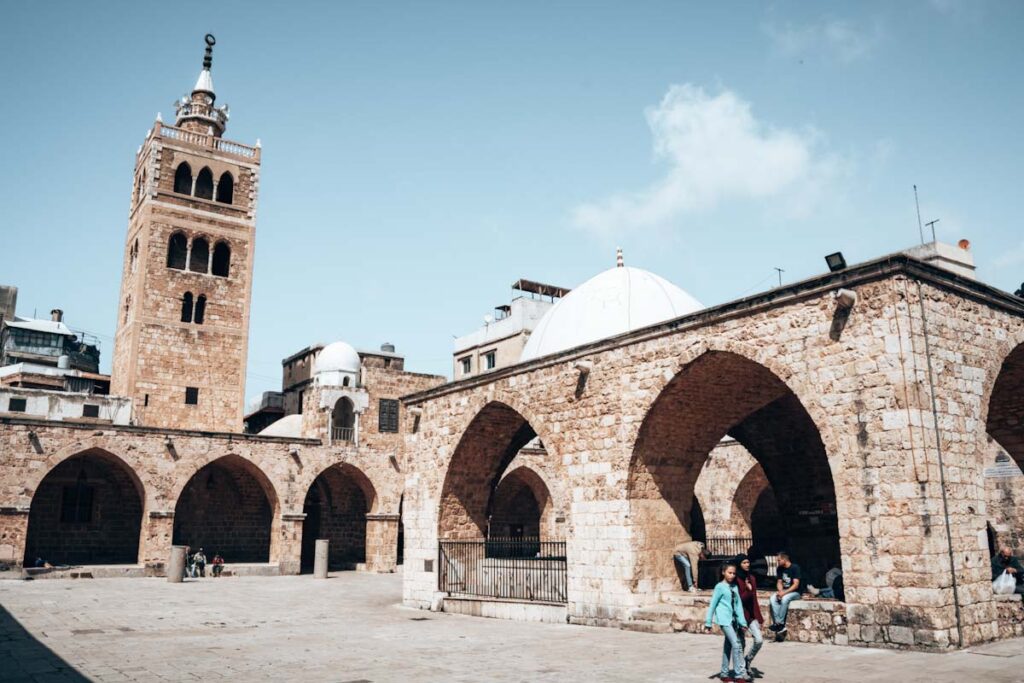
HOW TO GET TO TRIPOLI
Frequent minibuses are going from Dawra station in Beirut, but we recommend you take a Connexion bus. It’s a big direct bus that takes around one hour and a half to reach Tripoli. You can check their schedule here. They leave from Martyr’s square, opposite the mosque and cost LBP 50 000.
WHERE TO STAY IN TRIPOLI
Budget I City Guesthouse – former Seed Guesthouse is the only budget option in the city. We stayed here for a night. It is centrally located, just a few metres from the souk. Rooms are clean, and some of them even have a balcony. The owner is very helpful and provides you with many useful tips about places in the area.
Mid-Range I Azur Suites Hotel – located in the El Mina part, this beautifully decorated hotel has spacious rooms depending on the room, and you can also have a seating area. If you want to go to the bar in the evening, this is the best option to stay in.
Luxury I Aquarius Touristic Resort – to escape the hustle of cities, this place is a resort with everything you need: an outdoor pool, balconies, breakfast and other facilities.
DAY 7-8 BCHARRÉ
Escape the hustle of bigger cities and make your way to the mountains around Qadisha Valley. If you search for nature, some hiking options and perfect views from your room, make sure you have this place on your itinerary.
The best base to explore Qadisha Valley is a small Christian mountain village called Bcharré, located just a few metres away from the beginning of the famous Qadisha Valley Trail and Cedar forest.
Make sure you stay in Bcharré overnight. We stayed for two nights, and it was the best decision we made. After a busy Tripoli, it was an amazing escape. Also, it is unbelievable how quickly the atmosphere change between places in Lebanon. Again, it felt like we are in another country.
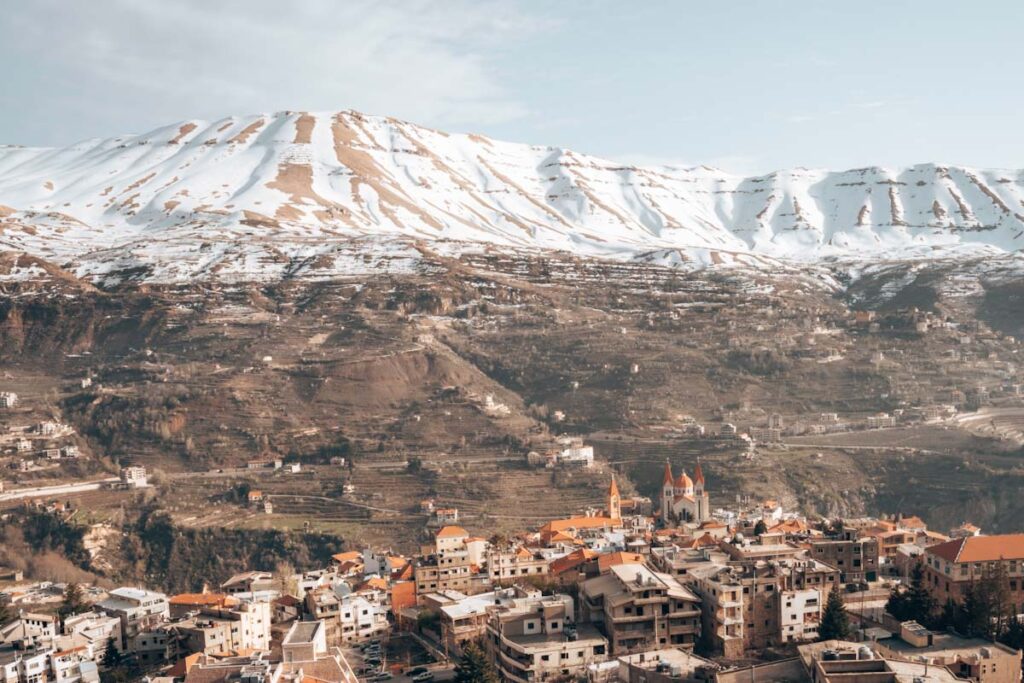
WHAT TO DO IN BCHARRÉ
The Mountain village of Bcharré is mostly about nature or/and relaxation. There are beautiful churches that are most of the day open for the public. What is very interesting is that some people here still speak Aramaic, which is the language of Jesus. Not many places in the world still keep the knowledge of this precious language. Other Christian villages where people know Aramaic are in Syria; we visited Maaloula and Sednaya.
Qadisha Valley Monasteries
A twelve km hike leads from Bcharré down to the Qadisha valley. It takes you to the monasteries still inhabited by monks. The beginning of the hike is behind the cathedral; from the right side, you see the set of stairs that take you all the way down to the big sign where the hike begins.
The beginning of the hike is the most difficult as the descent is pretty steep. You will have an amazing view of the other side of the valley. Especially in April, there is plenty of water, and you see many waterfalls making their way between the rocks.
The first monastery Deir Mar Elisha, visible from a distance, is open from 9 am till sunset. It is carved into rocks. From here, the trails lead through the bottom of the valley to another monastery that is 5km away. You can go back to the main road anytime and hitchhike a lift back to Bcharré or wait for the bus (the one from Tripoli or Beirut, you just wave, and they stop).
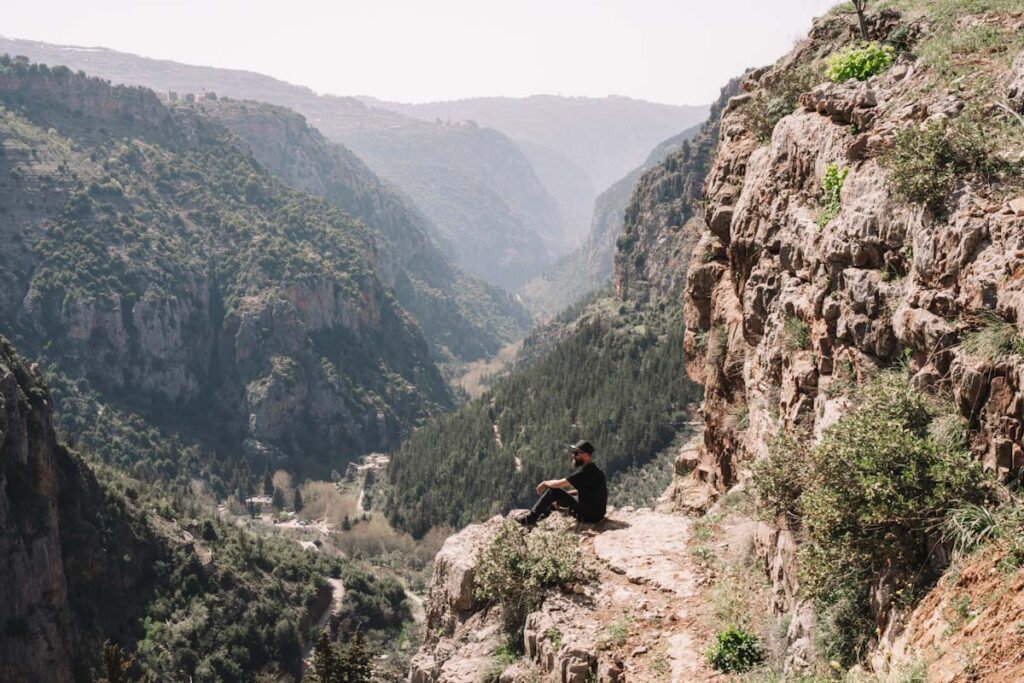
The Cedars
From Bcharré, it is a six km uphill; you need to take a taxi or hitchhike to get to the Cedars. Unfortunately, the Cedar forest was closed due to a high volume of snow in April, but we still get a view, at least from the road.
Taxis are pretty expensive; it costs LBP 350 000 to go there and back, with a driver waiting for you.
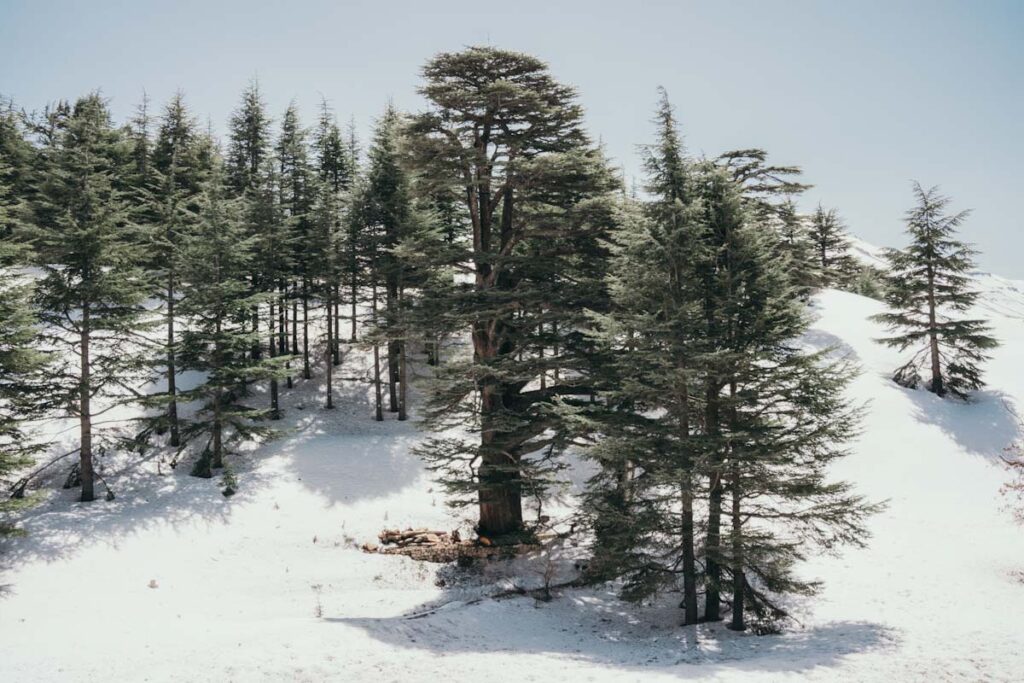
Churches
There are many churches in and around Bcharré. Especially on Sunday, it is very lively and nice to go inside.
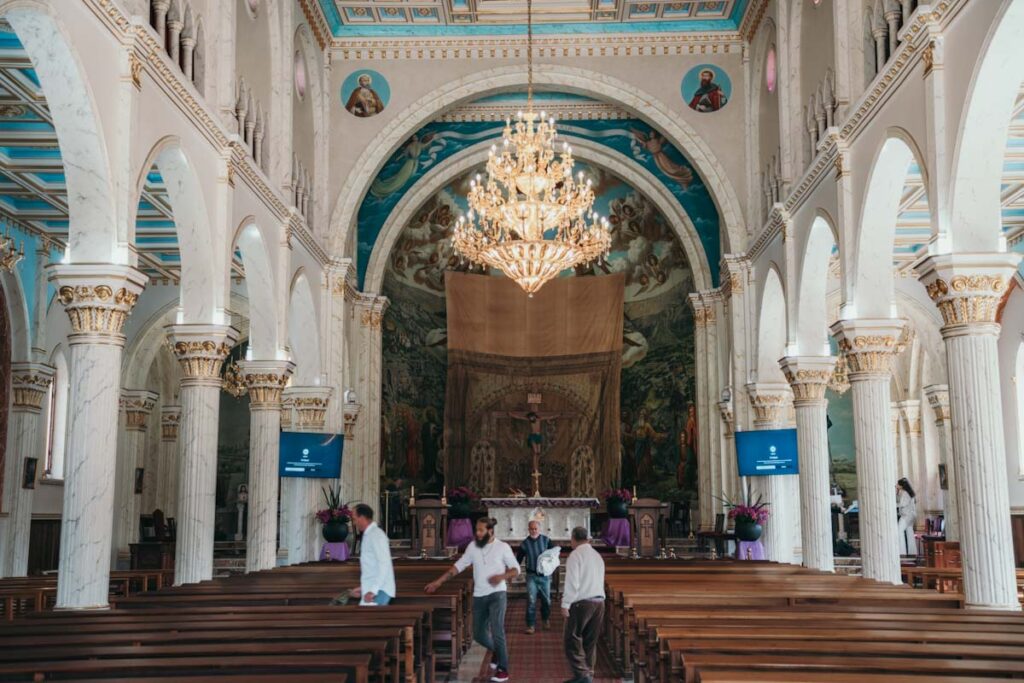
Where to eat in Bcharré
The best food we had in Al Zeitouni restaurant, the prices are good and food tasty. Mostly they have sandwiches – fish, falafel, chicken…
HOW TO GET TO BCHARRÉ
If you follow our itinerary, you go to Bcharré from Tripoli. Take a bus leaving from the roundabout in Abdel Hamid Karameh Square (exact location: 34.4345947, 35.8361633). Those buses have a set schedule, so make sure you come on time. They leave every day from Tripoli to Bcharré at 9:05am, 1pm, and 5:30pm.
To return from Bcharré to Tripoli, they leave outside Saint Saba Cathedral at 6:20am, 10:55am, and 3:20pm. Contact for a driver is +961 70 055 525.
There is also a direct bus between Beirut and Bcharré. It also leaves outside of the cathedral. The first one to Beirut leaves at 9am. Contact for a bus company is +961 3 534 701.
Don’t hesitate to contact the numbers on WhatsApp to check the current schedule.
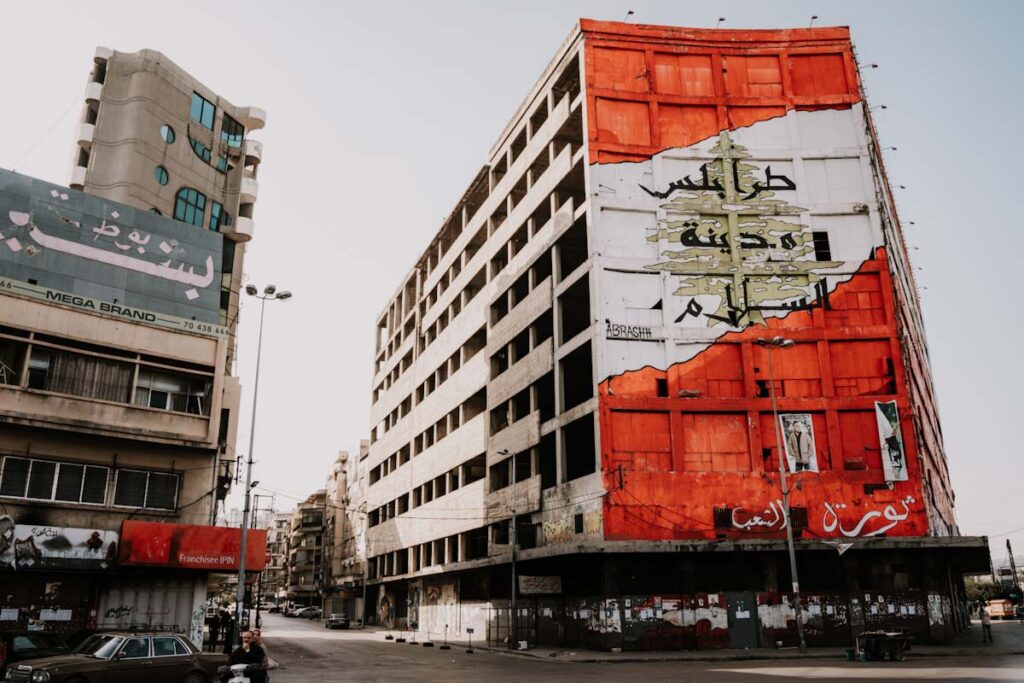
WHERE TO STAY IN BCHARRÉ
Budget I View Lodge Bcharré – the best stay we had in Lebanon. Such a friendly owner made us feel like at home. The homemade breakfast is excellent, especially the kiwi fruit jam from his farm. The house has a big living room with a huge window with an unforgettable view over the valley and snow-covered mountain peaks. It is centrally located, electricity, wifi and drinkable water provided. It is more like a wooden cottage with a fireplace, and there is also access to a rooftop, where you can have a cup of tea. If we can recommend you one place, make sure you stay here.
Budget I Tiger guest house – another budget option in town. It seems a very popular place as everyone is staying here. It is located quite up the hill, so be prepared to walk uphills multiple times a day, but it also means a better view.
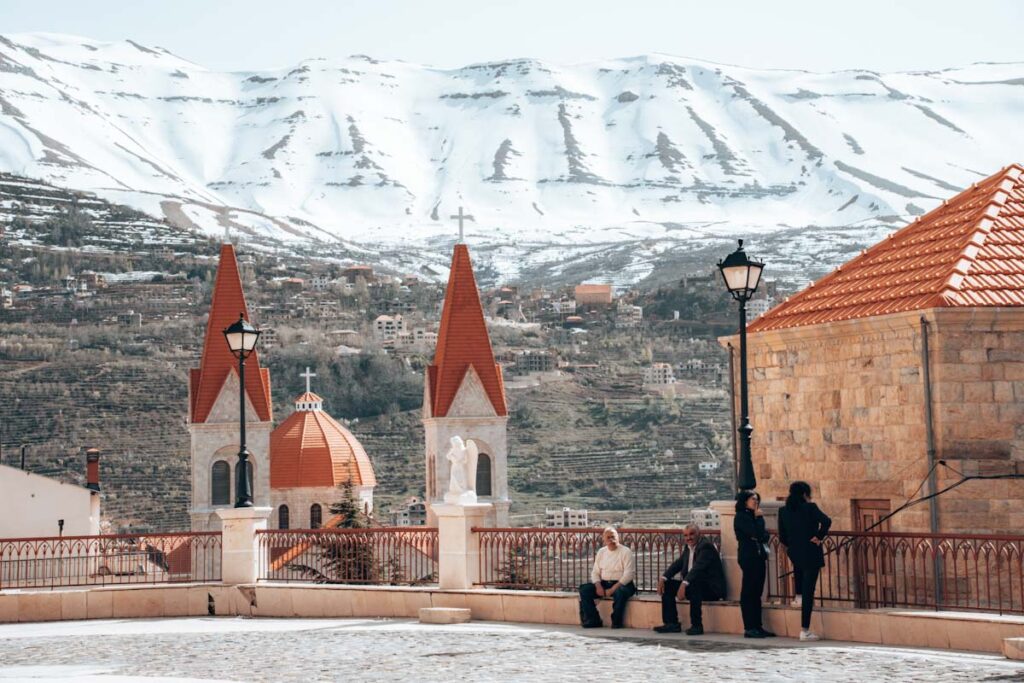
DAY 9-10 BAALBEK
Baalbek is located in Beeka Valley, close to the Syrian borders. Make sure to stay in Baalbek overnight. The city is different from others, with a beautiful shrine and impressive Roman ruins. It is also home to the oldest hotel in Lebanon. A night here was an experience with the same value as exploring the Roman ruins.
Before you go, make sure you check the safety situation, as Beeka Valley is home to Hezbollah’s headquarters, which you will see with yellow flags lining the streets. During our visit, the situation was stable; however, make your research right before you go. In these sensitive areas, the safety situation can change quickly.
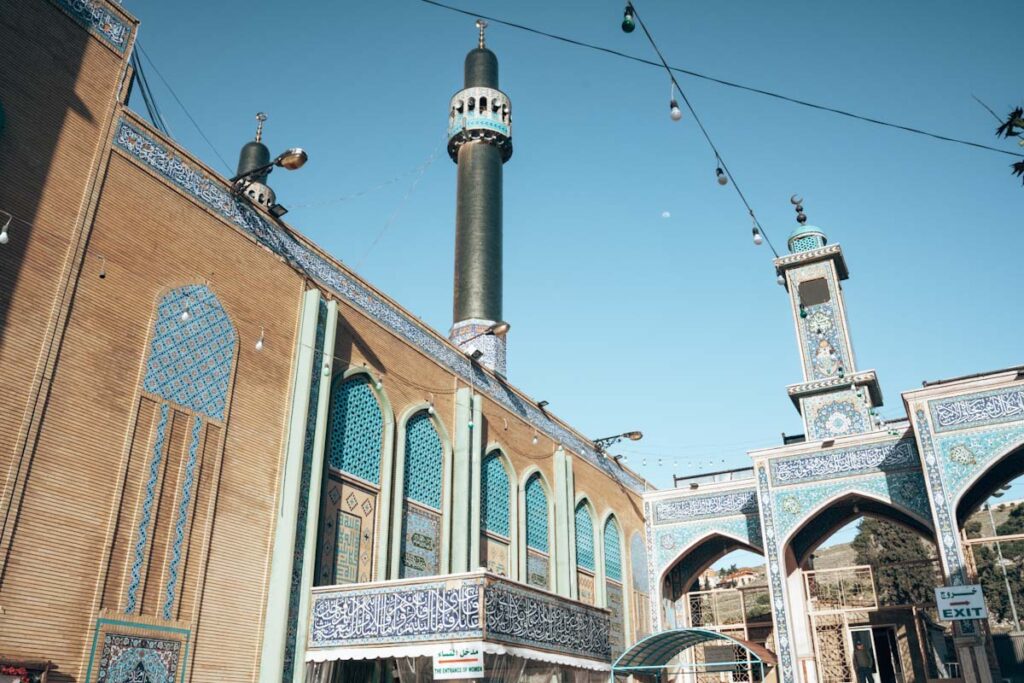
What to do in Baalbek
Baalbek Ruins
Ancient ruins from around 60AD are the best-preserved site in the whole Middle East. There were just a couple of people during our visit, so we felt like we had an entire area for ourselves. Amazing how beautiful the carving is with so many visible details. You need a good two hours to explore the site or, like us, stay in Palmyra Hotel, where you also get a view over the ruins, which are especially beautiful for sunset.
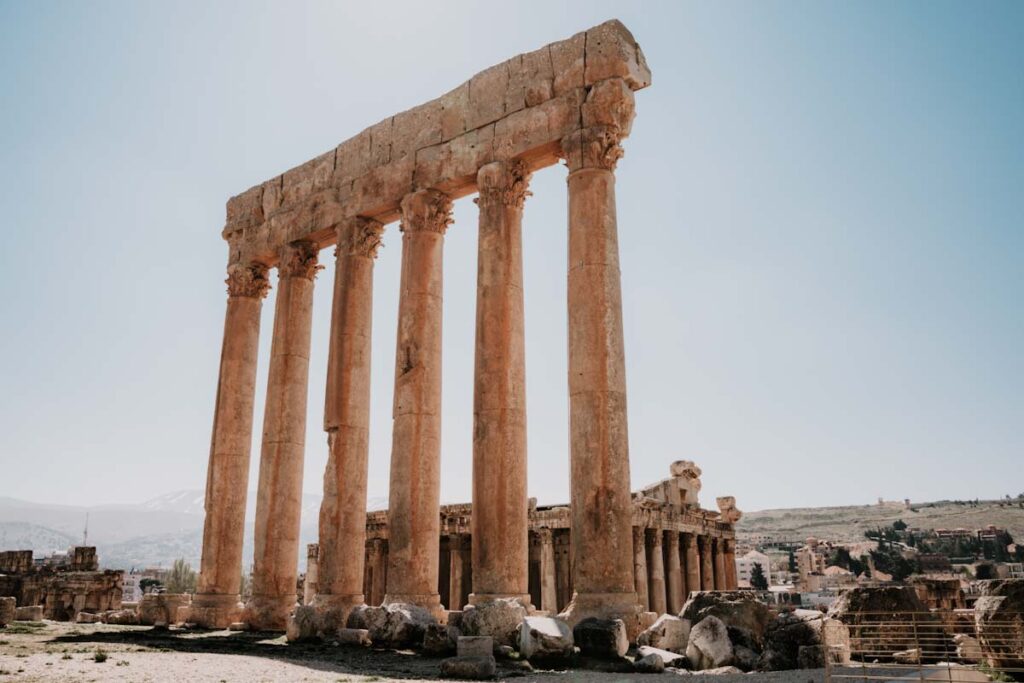
Sayyida Khawla Shrine
The Shrine of Sayyida Khawla, the daughter of Imam Hussein and great-granddaughter of Prophet Muhammad, is a special place and a different kind of mosque than we are used to in Lebanon. This design is the same as the shrines you see in Iran, with glass decorations inside and beautifully coloured outside. There are clothes to cover for women so you can visit. We met friendly locals who gave us a tour and explained a bit of history.
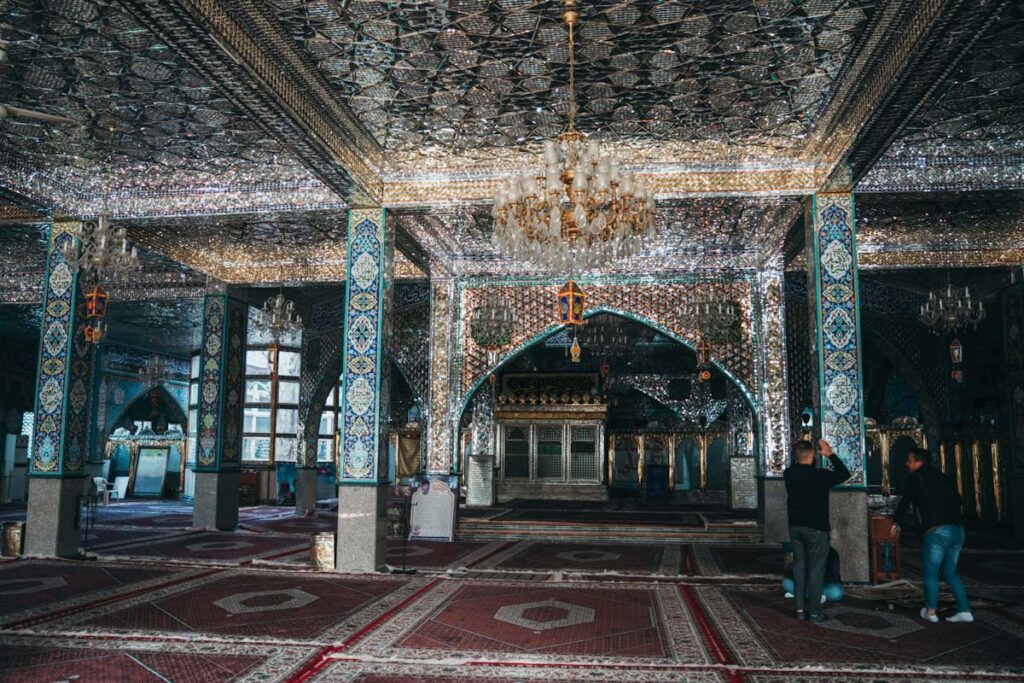
City Centre
Except for the ruins, mosque and Palmyra Hotel, we weren’t really impressed by the Baalbek city, to be honest. After you see souks in Tripoli and Saida, there is not much going on in Baalbek.
Where to eat in Baalbek
There are many small eateries serving shawarma or falafel and hummus, as well as sweets. But one bakery, in particular, caught our attention. They make fresh bread, different kinds of pastries filled with meat or cheese in an oven, the place is bustling with locals, and the pastry and bread are the best ones we had in Lebanon. The bakery is called Turn el Asdiqaa.
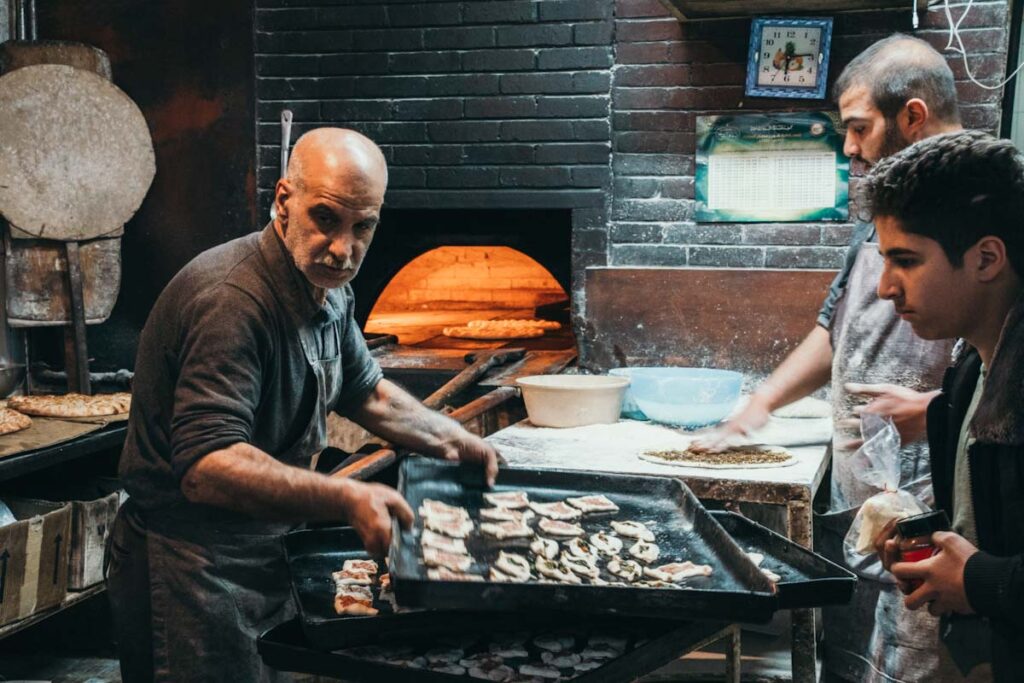
HOW TO GET TO BAALBEK FROM BCHARRÉ AND BEIRUT
From Bcharré, direct buses run from 9 o’clock to Beirut, Dowra station (2.5 hours, LBP 70 000). The bus stop is in front of the Saint Saba Cathedral.
Another option is to take a bus to Tripoli (1 hour 20 min, LBP 50 000), which leaves every day at 6:20am, 10:55am and 3:20pm. It drops you off at Abdel Hamid Karameh Square, from where you can catch a Connexion bus to Beirut (1.5 hours, LBP 50 000).
Then from Beirut, you need to take another bus that goes to Baalbek from the Cola intersection (2.5 hours LBP 100 000). Direct buses are frequently running, as well as minivans that go to Chtoura, where you change a bus to Baalbek. This transport took us 6 hours, so if you feel like it, you can break a journey and explore and stay overnight either in Batroun or Zahlé, two exciting cities that are along the way.
The best option is to take a bus from Bcharré directly to Baalbek, through the mountains. It takes only around one hour. But the road is open only when the snow is gone. In April, it was still closed.
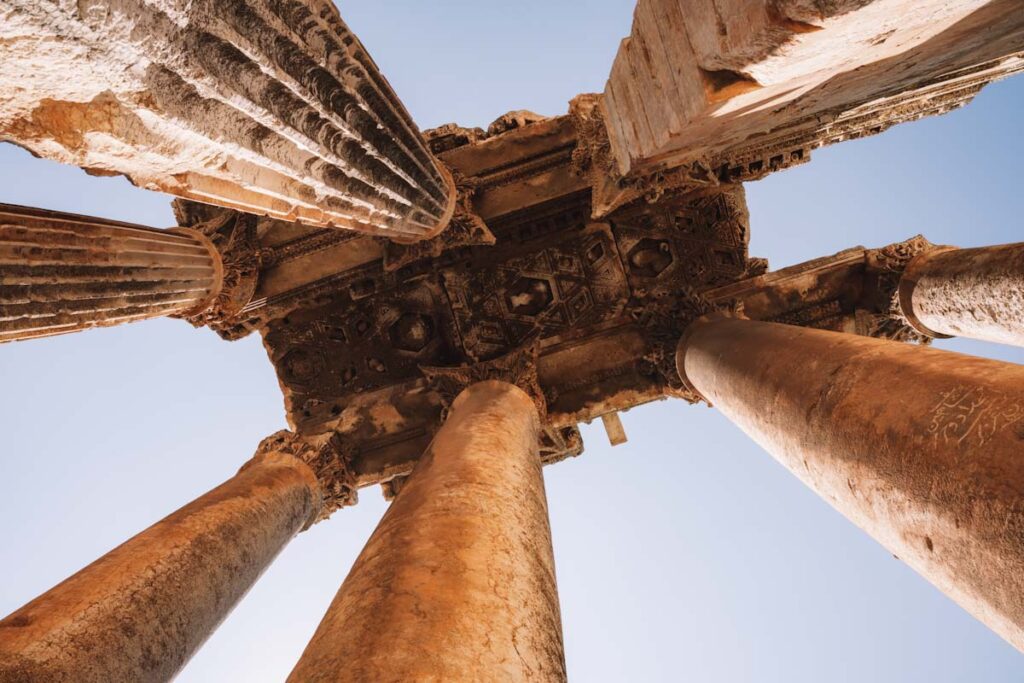
HOW TO GET FROM BAALBEK TO BEIRUT
Buses stay in front of the Palmyra Hotel and frequently run throughout the day. We took a bus to Chtoura and from there another bus to Beirut. The way to and from Baalbek was the only one in Lebanon where drivers wanted us to pay more money than locals. We had to pay also for our bags, and they dropped us off not in the Cola intersection but in some random part of Beirut. On the way back, we paid LBP 150 000 per person.
WHERE TO STAY IN BAALBEK
Mid-Range I Palmyra Hotel – the oldest history-filled hotel in Lebanon is like a stay in a museum. It was built in 1874 and has never closed ever since. It hosted famous people such as Charles de Gaulle, Albert Einstein, Ella Fitzgerald and many others. We loved our stay here, and it was the highlight of our trip to Baalbek, together with the impressive ruins that you actually see from your hotel room. We contacted them directly through WhatsApp +9618370230 and managed to get a price of $30 per night with an amazing buffet breakfast.
Mid-Range I Kanaan Hotel – the only option that can be booked online is Kanaan Hotel, a decent hotel with breakfast included, it is 15 minutes walk from the ruins.
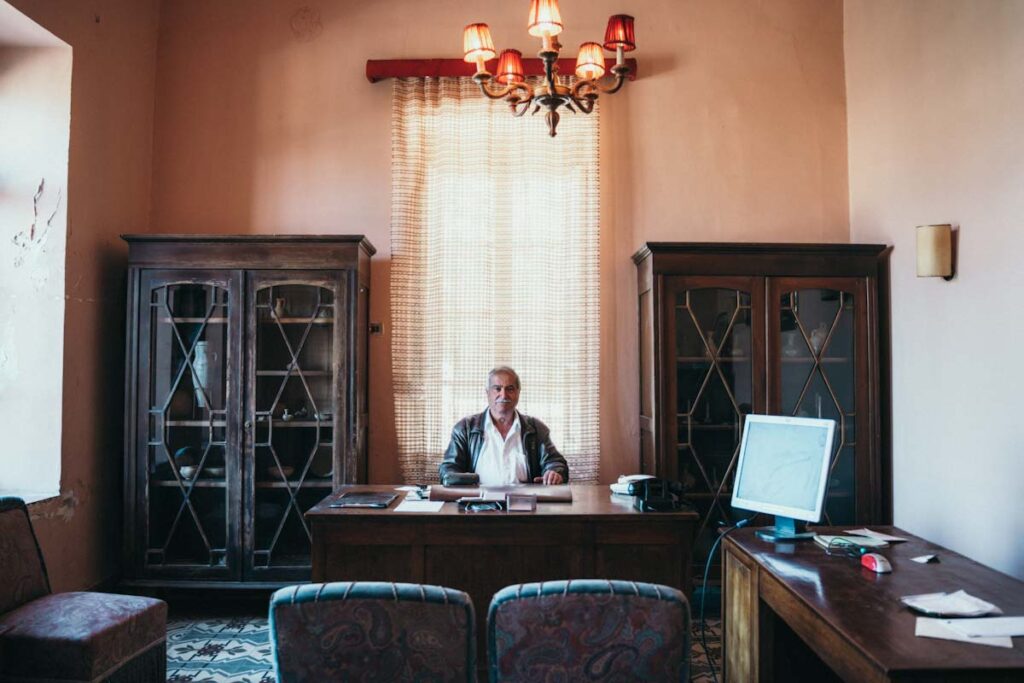
DAY 11 Back to Beirut & Other places
If you have more time, you can visit Mleeta – the Hezbollah Resistance Museum, an open-air museum showing the battles between Hezbollah against the Israeli troops. To get there, you need to take a service taxi from Saida. Or you can take a bus from Beirut, which leaves near the Kuwaiti embassy and takes you to the Nabatiyeh village, from where you take a service taxi to Mleeta.
If you are interested in a more offbeat location, the 2,500 year-old Pyramid of Hermel is a great place to be! Nobody is quite sure who build it but still, it’s standing there! To learn more about these cool locations, read Rowan’s in-depth article about Lebanon at Quit & Go Travel.
USEFULL TIPS
- We experienced one checkpoint when travelling by bus in Lebanon on the way to Baalbek. So it is better to have a passport always with you.
- Check the current lira rate on the black market on the Lira Rate app.
- Bring a power bank and headlamp. You will need it.
- Don’t leave any chargers in a plug when not charging. Why? We made a mistake; we left the chargers in a plug after charging our things. It burned all of them down completely.
- Everyone communicates via WhatsApp – even hotels, bus companies, and drivers. Everyone.
Onward travel
Lebanon is the best gateway to travel to Syria; many people cross the overland border daily, and it’s the easiest overland border crossing you can do. We crossed the overland borders from Lebanon to Syria in April 2022. You can read our detailed travel guide below:
Read: How can you travel to Syria in 2022 & Is it safe to visit?
SAVE IT!
It’s time to plan your trip!
Find our travel resources below that help you plan your next trip. Good luck and safe travels.
Book your flight
Skyscanner is our favourite tool for searching for the cheapest flights and flight combinations. Multi-city or Explore Everywhere helps us to find real bargains.
Rent a car
The best platform to rent a car and compare the prices for your next road trip anywhere in the world is Discovercars.com. The booking process is hassle-free.
Find your acommodation
On Booking.com we always find the best deals for accommodation. Another great option for cheap accommodation is Hostelworld.
Travel insurance
We always recommend IATI Travel Insurance which offers excellent plans. As a reader of Broken Navigation, get an exclusive 5% discount.
For Europeans Truetraveller offers perfect travel insurance for the best price.
Explore more with Tours
Some places are better off explored with a knowledgeable guide. Or, if you simply want to save time and hassle, we recommend GetYourGuide. Another great option that also has an amazing range of activities is Viator.
protect yourself online by VPN
We always use NordVPN everywhere we travel for safe internet browsing and access to specific sites that might be blocked.
Disclosure: We recommend only companies we personally use. If you book services through any of the affiliate links in our posts, it earns us a small commission at no extra cost to you.

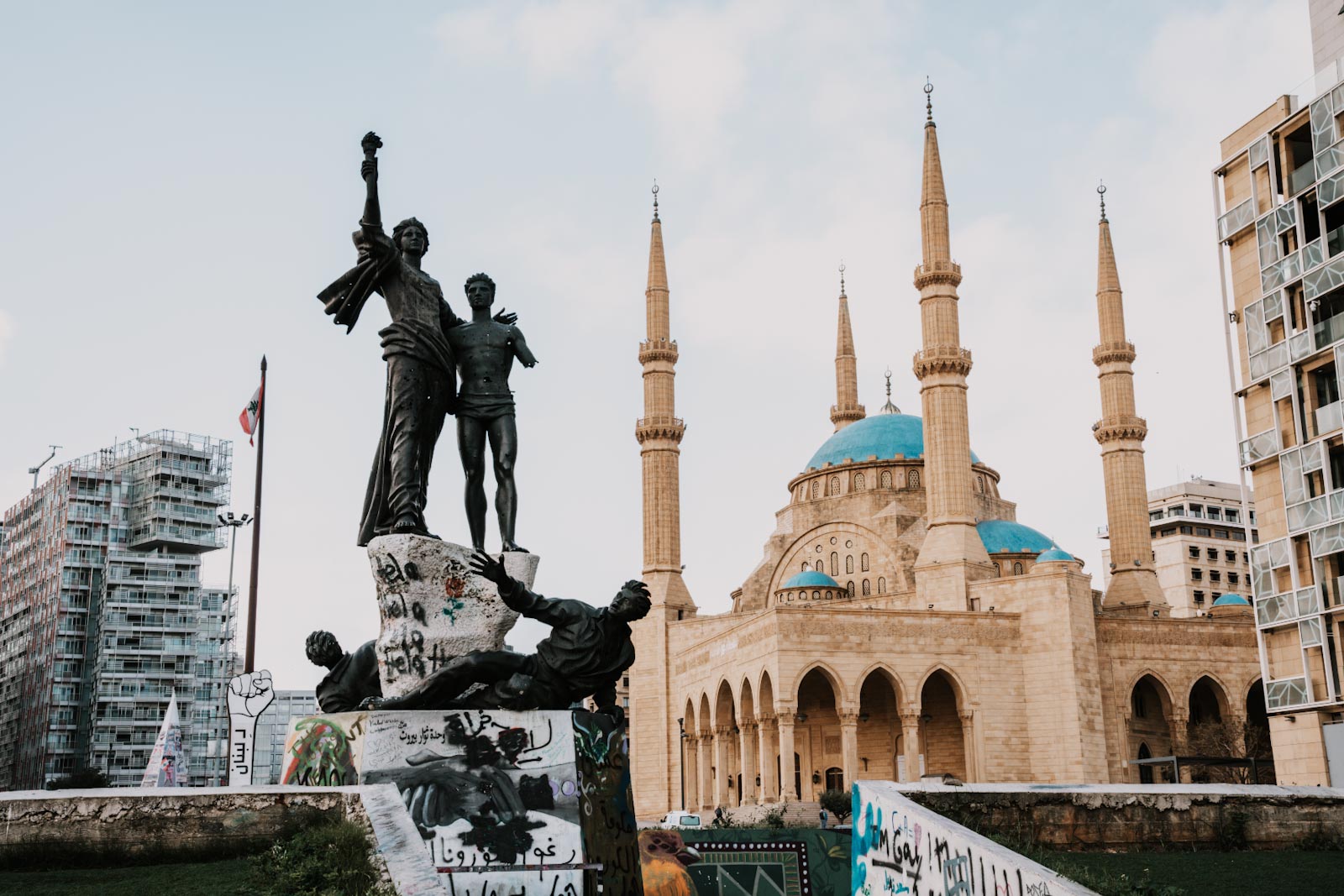
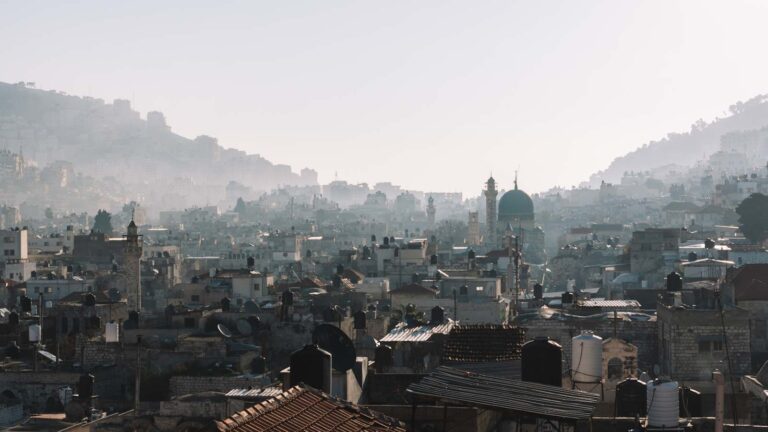
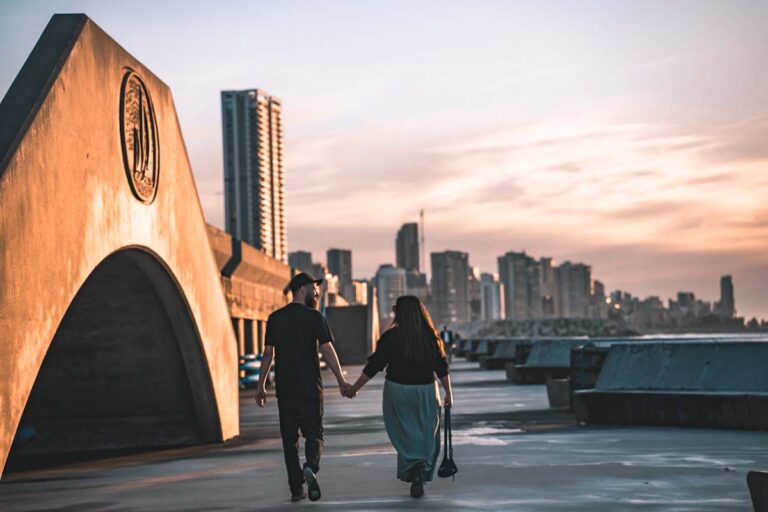
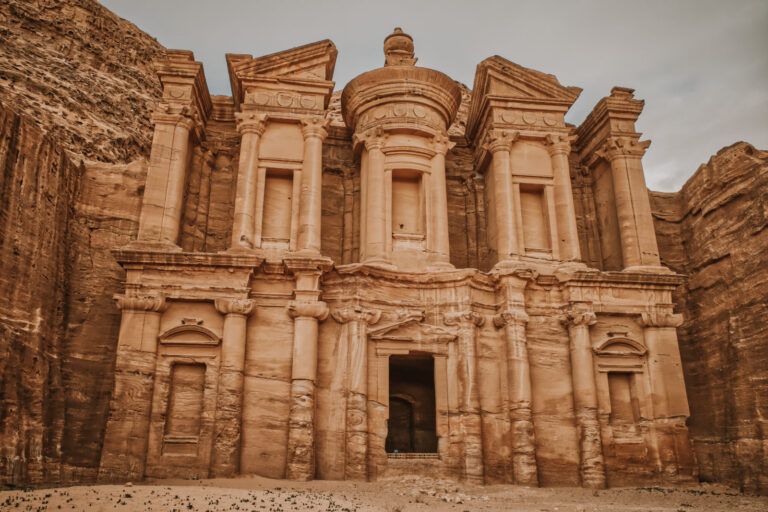
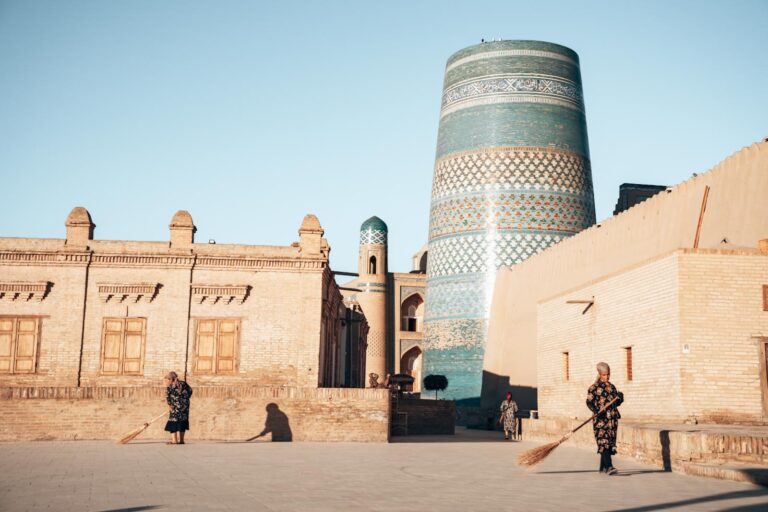
Guys, I read an article about Lebanon. Very interesting and informative, and most importantly, everything is very detailed. I also wanted to go there. You are great, continue to please with new articles.
Thank you so much! We appreciate it!